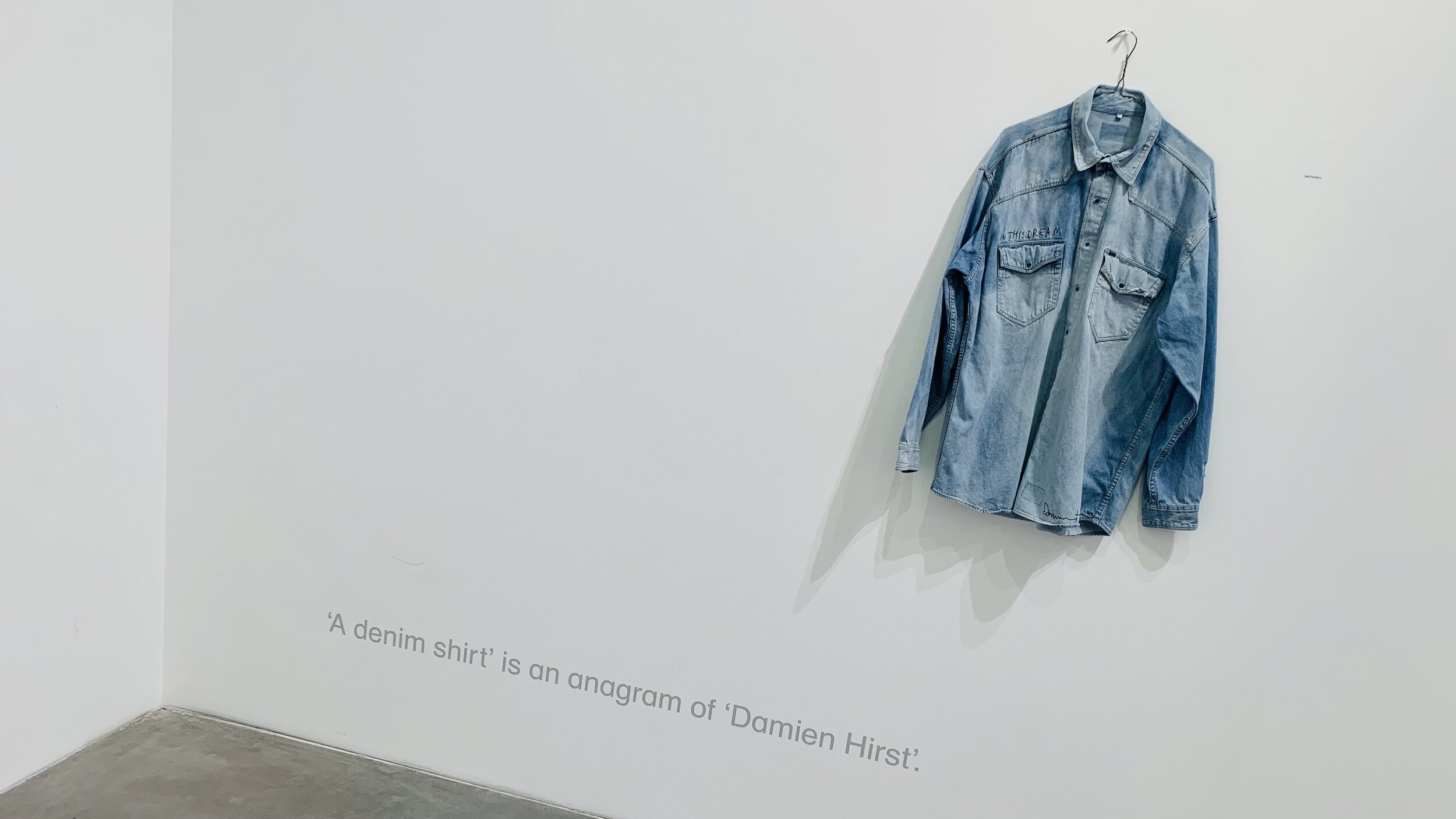One project in my portfolio Macbeth, one of Shakespeare's four great tragedies, after doing a lot of research and seeing the movies and dramas produced by predecessors, I came up with the idea of making it stand on reality, that is, from its original story background, Scotland in the 11th century. After seeing it, my idea was to show the hero's psychological problems through costumes and accessories. A picture emerged in my mind: a huge black net appeared in the sky, invisible linear giant hands in the control of the hero's fate, like puppets, leading him to the abyss. I think the core of this story is the psychological externalization of the tempted hero. Similarly, at any time, such a thing will happen. This is a story about human nature. Because of the desire of one's heart expands little by little, thus reaching an irreparable point. What makes me interesting is how much this invisible external factor affects a person. I'd like to know more about research and spend more time on it. Back in my work, I used a more modern, simpler and exaggerated form of expression in my design. This form of expression is also integrated into my own symbols, because I think I am a very conservative looking, but my heart is very eager to exaggerate, be more fashionable and more forward-thinking people. In my works, this is totally my own. Through my works, I can reflect the hero's experience of several periods, psychological changes will show different forms through costumes.
With the understanding of the work, I feel deeply attracted by the theme of the symbolic drama. In symbolic drama, symbolism is an integral factor closely related to the theme of the play, the character's personality and even the plot structure, and is an important factor that the playwright consciously considers in the process of planning and layout, because anything in the play has its value of existence and is a kind of metaphor. The real world and the subjective world are actually a whole, coexisting in time and interpenetrating in space, sensing each other. And this kind of penetration is universal. This mysterious penetration and induction exist between all things, between subjective and objective, between people and things, and between all the senses of people. This mysterious universal induction demolishes the barriers of confrontation between things, so that things can express each other through a kind of mutual resemblance, using this thing to symbolize the other thing, using the visible world to know the invisible world, thus making the act of symbolism possible.
Yayoi Kusama is an artist with her very unique signatures. Her works are very recognizable and full of personal style. I can’t help but thinking of her whenever I see dots or pumpkins. Her works are autobiographical, psychological and sexual. She suffers from neurological audio-visual disorder and hallucination from a young age. The world she sees is covered in a huge net, so she keeps drawing, trying to recreate her hallucination with repeating dots. She expresses her fear towards dots to an extreme. I think the reason of her success is that she is courageous enough to face her fears and transform it into art. This is also something I would like to experiment.

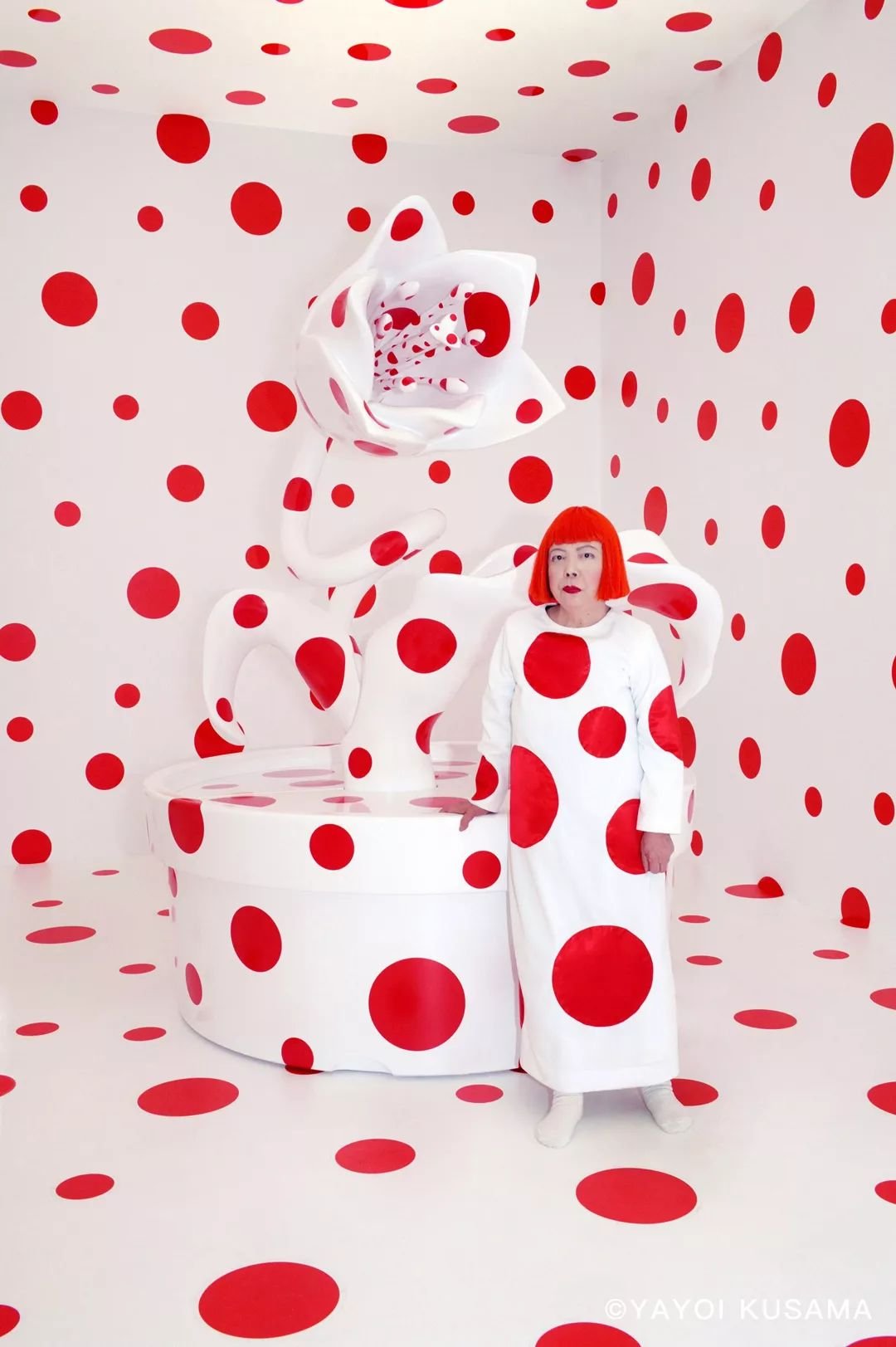
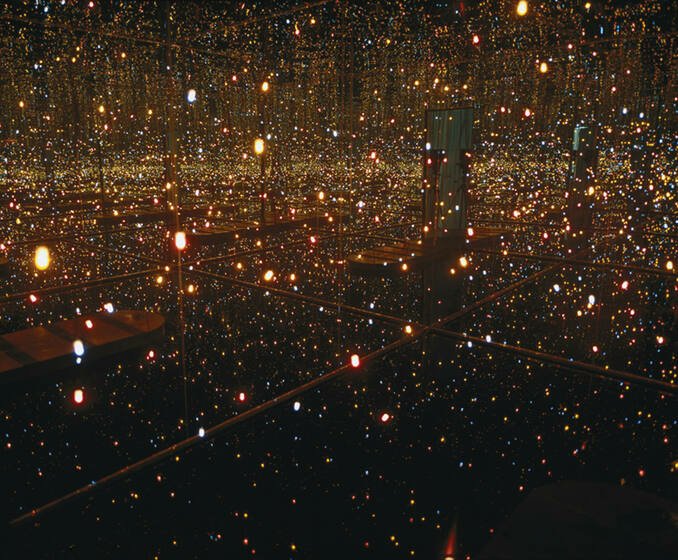
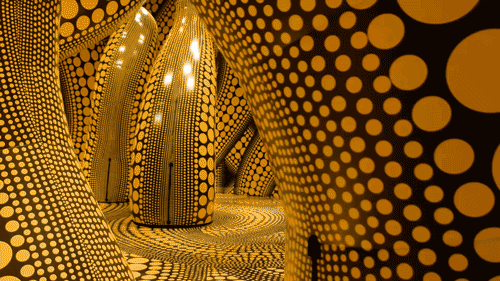
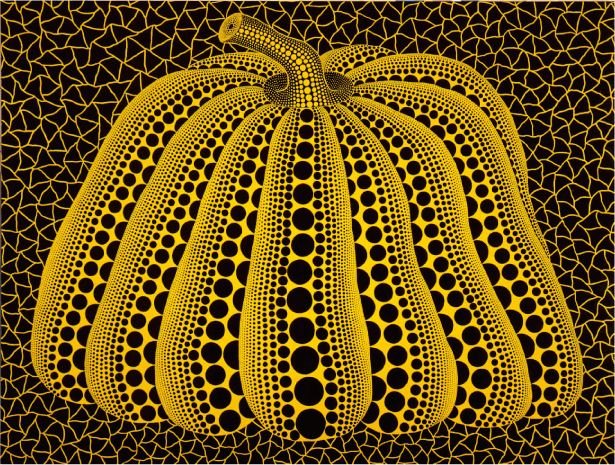
I’ve read the script of the symbolist play The Sunken Bell by German playwright Gerhart Hauptmann. In the play, the combination of reality and illusion indicates the writer’s longing for a beautiful world. Hauptmann’s writing is the transition from naturalism to realism, then to symbolism. He focused on discovery of self-worth. The characters walk between reality and illusion, exist in real life and imagination, which provides endless place for imagination. Inspired by him, I am prone to study the struggle between the character’s inner world and reality, which is a very interesting topic to me. To present the inner world of a character, other than costumes, stage design is also an essential element.
Picasso once said, "The artist's eye, can see above reality." We all know that artists will incorporate a lot of personal emotions in their creations, and will use art to express their feelings, the relationship between people, the relationship between people and nature, the relationship between people and the future, and even more imaginary and unrealizable things. Sometimes, due to various limitations, when it comes to expressing what is in your heart, you may not be able to express it or even if you do, you may only express 50% of your original plan. So how to properly express what is in your mind and how to combine what you have learned to express what is in your mind is especially important. Some people may be forced by reality to convince themselves to compromise, but others slow down and take their time to perfect their work. Thankfully, with the development of technology, more and more designers can express their feelings through technological means. Multimedia digital art, immersive VR experiences, virtual costumes and characters, and holographic three-dimensional stages all embody innovative concepts at this stage. Applying these technical means to the stage, combined with the costumes, will produce a very wonderful new experience.
I did the project The Sunken Bell during my graduate studies, and I set it up as an immersive theatre. The audience acted as NPCs playing the characters in the play to go through what the male lead experienced. I designed a scene where the contrast between the real world and the imaginary world is huge. One is a black-and-white distorted space full of lines that create discomfort, while the other is a relaxed, natural, and joyful scene. My aim is to make the audience feel vicarious, to be able to step into the inner world of the characters, to perceive, to experience.

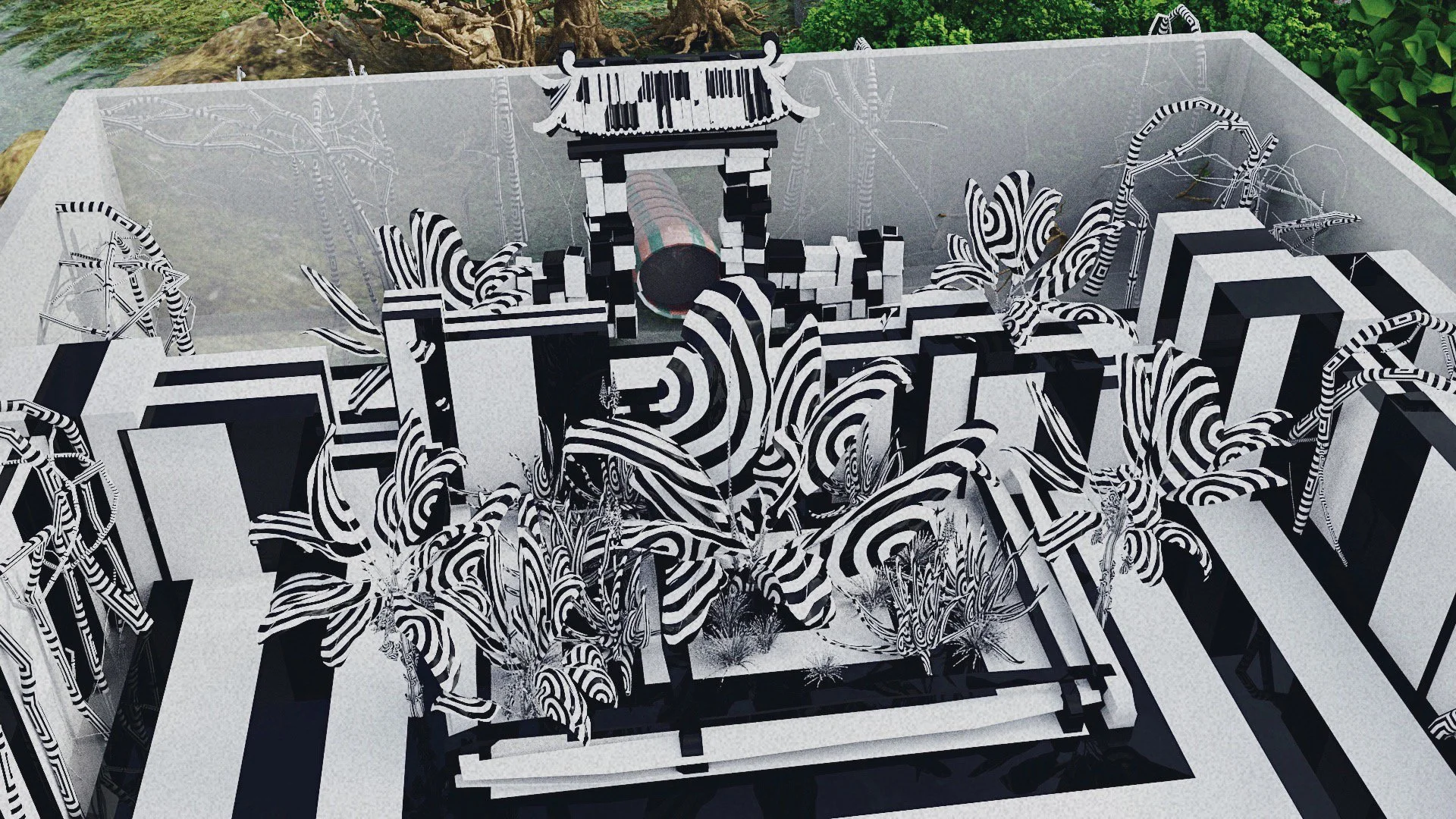

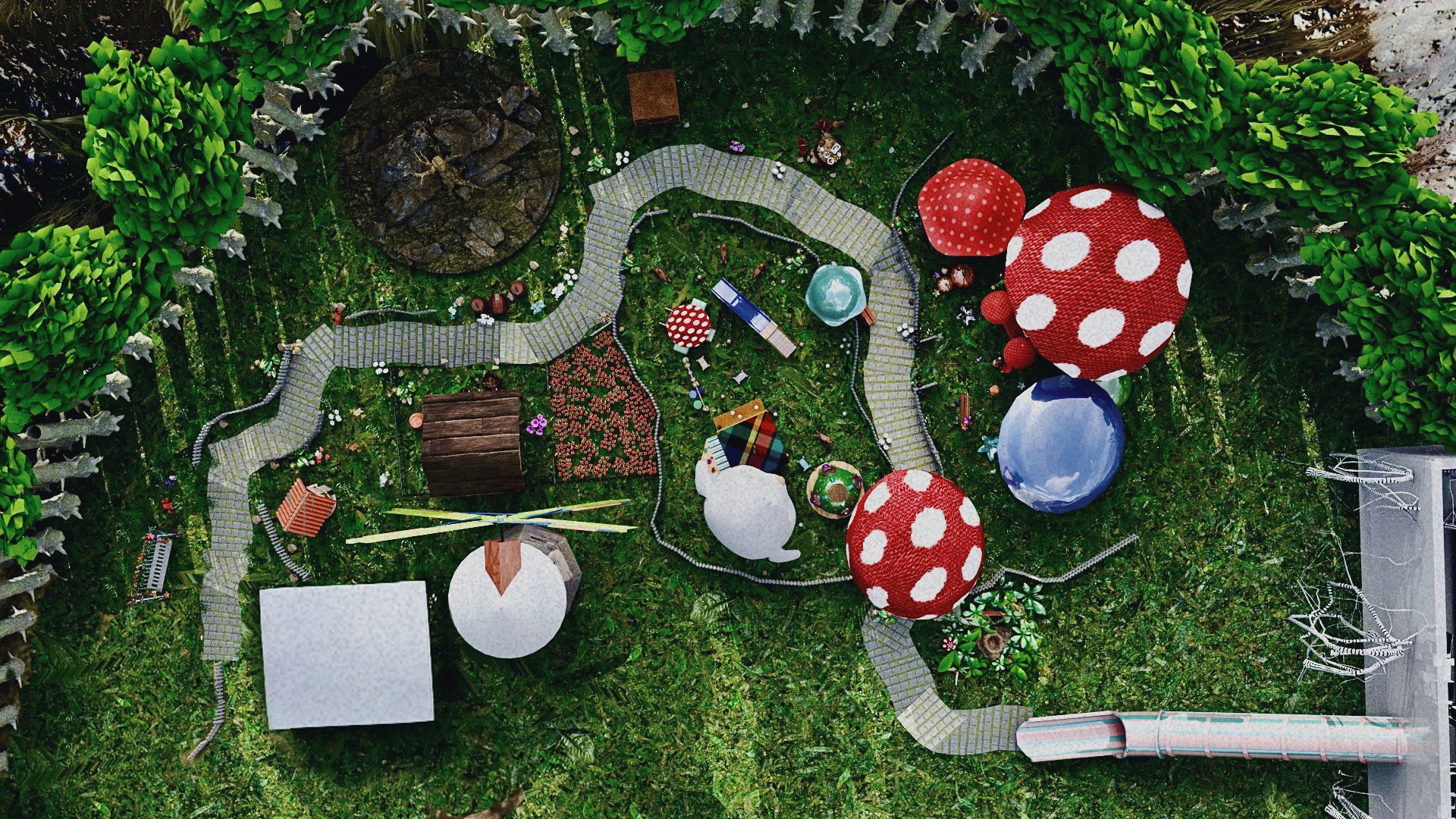

In addition, during my university years, I had the opportunity to participate in a school production of the play The Green Bird, an adaptation of the playwright Maeterlinck's masterpiece, in the creation stage of this play, Professor Zhang Qingshan combined stage design and costumes, and designed a "magic cube" according to the changes in the play's environment, through a set of square boxes, with the actors' performance movements This not only promotes the development of the play but also presents the scenes in the play in a minimalist way. The charm of the stage is infinite, and the imagination of human beings is infinite, and anything can be transformed into a symbolic image with characteristic meaning through clever means.
Covid-19 has caused great damage to the overall theatre world. People can’t enjoy the shows in theatres and participants of the theatre industry have very limited chances to demonstrate their talent. All those bad stories really break my heart, and I believe people who love this art also feel the same. I want to become a part of the power that helps the theatre world to rebuild its glory when the war against covid is over. Based on my academic background, practical experience and my personal interest, my recent focus will be to discover the interaction between digital technologies and traditional theatre arts. To be more exact, I would like to see how AR/VR, holographic projection, digital imaging, 3D modelling and metaverse add color to the modern theater art.
Which artists and works of art Jay paid tribute to in “Greatest Works of Arts”
Background
The MV opens with La samaritaine, the most famous Parisian department store founded in 1870, which has been losing money since the 1970s and was closed in 2005 due to safety concerns in the building. It was later rebuilt by LVMH and reopened on June 23, 2021.
Its first architect (1915-1910) was Frantz Jourdain. If you are interested, you can read the book "Frantz Jourdain and the Samaritaine : Art Nouveau theory and criticism".
By the time the department store was completed in 1910, new movements, such as Fauvism, Cubism and the Walker Bend School, had emerged and devalued the Samaritaine style. In the 1920s, both Cognacq and Jourdain realized that the original style of the building was outdated. The glass dome and the decorative ironwork were removed. The new building, a collaboration between architects Jourdain and Henry Sauvage, was completed between 1926 and 1928 and features cream-colored stone in an Art Deco style. Similar to the original building, it uses exposed steel, but its emphasis is based more on geometric forms.
La Samaritaine was acquired by the luxury goods company LVMH in 2001. On June 15, 2005, the department store closed in order to update the 19th-century building to modern safety standards, or to restructure it, as the unions believed. The LVMH group chose the Japanese architectural firm Sanaa to renovate the building. The implementation of the new design was repeatedly blocked by the local authorities due to a failure to comply with planning requirements and a lack of visual compatibility with the surrounding buildings. In June 2015, one of the Rivoli building permits was finalized and construction began in September of the same year. The modern building's Samaritaine design features a hotel, restaurant, brewery, café, offices and housing, and is expected to be completed in 2019. However, the renovated building will not actually reopen until June 2021.


1.René François Ghislain Magritte
Belgian surrealist painter. He is known for his surrealist works with a touch of wit and many thought-provoking symbolic languages. His work challenged many observers to conceive of reality in advance, and influenced many of today's illustration styles.
Works: "Betrayal of Image" also known as "This is Not a Pipe" 1928. "Son of a Man" 1964. "The Man in the Bowler Hat" 1964
The gentleman in the bowler hat and black coat is Magritte himself. He used a pigeon that happens to fly in front of his face to block his face. According to his own explanation, he wanted to contradict most of the Surrealist painters in Paris and despised the use of color for portraits. He only wanted to tell the viewer that the portrait on the painting was just an ordinary, middle-class citizen. Since he never painted anyone else, he certainly avoided painting himself. Sometimes, either the figure's face is turned away or it is obscured by chance. This is another characteristic of his surrealist portraits.
He says this about his work Son of Man: "[The painting] covers the face very well... This kind of thing happens all the time. We see things that are always obscured from each other, and we always want to know what is being obscured... It's not simply a question of what is blocked and what is not blocked... It is a question of the difference in visibility between what is blocked and what is not blocked."
He says of his work "Betrayal of Image", "O famous pipe, people always use this to criticize me. Yet can you fill my pipe? You can't, because what's in the painting is just a symbol, isn't it? So I would be lying if I wrote something like "This is a pipe"!
2. Salvador Dalí
A Spanish surrealist painter, he is considered one of the three most representative Spanish painters of the 20th century, along with Picasso and Miró.
Works: "Eternity of Memory" 1931. "Lobster Call" 1936
His upturned beard is his most obvious personal characteristic. His work is a surprising mixture of grotesque dream-like images with a remarkable draughtsmanship and a painting technique influenced by the Renaissance masters.
He considers himself to be the expression of a "personal dream and hallucination revealed by Freud". In search of this surreal hallucination, they explored the consciousness of psychopaths, as Dr. Freud did, believing that their words and actions were often a sincere reflection of a subconscious world that was not seen in everyday life. For the Surrealist painters, this was some of the most precious material. Therefore, many of Dalí's works always combine concrete details and arbitrary exaggeration, distortion, omission and symbolism to create a "surreal realm" between reality and imagination, between the concrete and the abstract. Reading his paintings, one can understand all the details, but as a whole, one feels that they are absurd and horrible, defying logic, grotesque and mysterious.
The Lobster Phone is a work he made in 1936 for Edward James, a British poet and surrealist art collector. In his autobiography, The Secret Life of Salvador Dali, Dali reveals the motivation for the work in a playful tone: "I wondered why, whenever I ordered the grilled lobster in a restaurant, it didn't come with a grilled telephone."

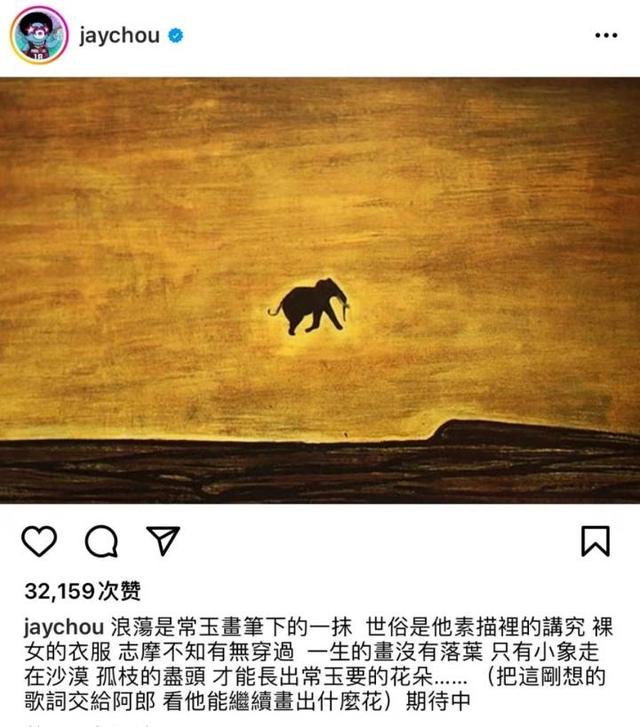
3. San Yu
French painter of Chinese descent. He is often referred to as the "Matias of the East" and the "Mondigliani of China".
Works: “Nu”1965. “Potted Chrysanthemums“1968
SanYu went to Paris in 1921 and began a legendary life, rooted in the deep oriental mother culture while absorbing the avant-garde color expression, opening up a unique personal style that blends the East and the West, making her unique in the Parisian school of painting and having a profound influence on the local art scene. The poet Hsu Chih-mo once described Changyu's round, voluptuous and powerful nude women as having "cosmic thighs" (more on this story below).
The Nu is ostensibly a human being, but in fact, SanYu is applying the majestic creations of Chinese landscapes to the human body. SanYu borrows Western-style colors and line composition to write about the magnificent and hidden atmosphere of the East. This "Cosmic Thighs" in the eyes of Hsu Chih-mo presents, as always, the simple and exaggerated fatness of the lower limbs of nude women in SanYu's paintings, and its lines are thicker and more vigorous than those of earlier nude women, with strokes of gold and stone like knives, without the softness and elegance of his youth, which focused on the fat and fullness of the muscles, but with a more unbridled certainty and maturity. He has brought out the most forbidden part of human civilization for thousands of years in a bright and frank oriental aesthetic style. This admirable expression of maternal grandeur is integrated into the simplicity of the Chinese style of writing, and "Naked Girl with Bent Legs", as the ultimate masterpiece of his life, is an unprecedented oriental expression, which can be called the pinnacle.
Under the impact of Western modern thought, SanYu experimentally reinterpreted Chinese artistic traditions to achieve a cross-cultural aesthetic mood. Nude women, flowers and animals were the three main themes in Changyu's work, and his early works were light in color and smooth in line, with a delightful romantic mood in pastel white tones.
He drew inspiration from Chinese porcelain motifs, and tablecloths and carpets with printed text were his objects of observation. In his still life works, flowers and roots bloom quietly against a background of intense color; the moving lines and planes challenge perspective, and each object, pattern, detail, and swirl are equally strong and captivating, in the same way as Matisse's work.
4. Henri Émile Benoît Matisse
French painter, sculptor and printmaker, he was the leader of the Fauvism. Together with Picasso and Marshall Duchamp, he brought about great changes in the plastic arts at the beginning of the 20th century. The Fauvists advocated the theory of Impressionism, which led to the first art movement of the 20th century. The use of bold and flat colors and unrestrained lines is Matisse's style. His playful structures, vibrant colors and light-hearted themes are the characteristics that made him famous and made him one of the most important figures in modern art.
Work: “Open window”1905
His interest in Chinese art was evident as early as 1919 in the costumes he designed for the Ballets Russes dance "Song of the Nightingale". The performance was set in the ancient Chinese court. The costumes are painted directly on the fabric, the heavy jewelry is carved from wood, and Matisse instructed the makeup artist to create the actors' makeup based on Chinese masks. The brightly colored curtains are decorated with Chinese griffins and black masks, while the actors dance on stage in brightly colored embroidered robes. In a letter to his wife, Matisse said he wanted the interiors to look like "his paintings.
Matisse's passion for the Orient went far beyond the theater. He copied Chinese sculpture at the Musée Guimet and often visited the Victoria Abbott Museum to view the Chinese, Persian and Indian art collections. Although it is certain that he had seen the work of the Chinese artists around him, it is not known whether Matisse ever met with SanYu. Yanfeng Chen, a scholar of SanYu, believes that Matisse may have seen SanYu's work and painted the figure's hands and feet in a soft and subtle manner in one of his own portraits dated 1946, a technique common in SanYu's portraits from 1925 onward.


5. Oscar-Claude Monet
French painter, representative figure and one of the founders of Impressionism.
Works: ”Impression Sunrise” 1872. “The Water Lilies”1919. “Self-portrait with Palette”
Monet excelled in the experimental and expressive techniques of light and shadow, and his most important style was the change in the way he painted shadows and contour lines; there are no very clear shadows in his paintings, and there are no accentuated or flat contour lines. In addition, his use of color is quite delicate, and he has long explored experimenting with the perfect expression of color and light, often at different times. He often made multiple depictions of the same subject at different times and under different light.
The most moving picture here is Jay taking the impressionist master to see the water lilies in Chinese painting style


6. Hsu Chih-mo
He is a native of Haining, Zhejiang Province. He is a famous modern poet and essayist of the New Moon School in China.
Works: “Pieces of Paris”1927. “Saying Good-bye to Cambridge Again“1928
Balzac, the great French writer, wrote: "The counter of the café is the council chamber of the people." The French Revolution, the Enlightenment, Existentialism and other political, social and cultural trends all came to society from the café. Therefore, for the French who love romance, mood and atmosphere alone, if there is no coffee as incredible as no wine, it can simply be said that the end of the world has arrived.
Hsu Chih-mo once said, "If Paris were fewer cafes, I'm afraid it would become not at all lovely."
Bing Xin said at Hsu Chih-mo's memorial meeting "Chih-mo was a butterfly, not a bee, and the benefits of women were not gained, and the disadvantages of women made him sacrifice."
(Here's the explanation: women are flowers, and if Chih-mo were a bee he would be able to collect honey and get the benefits of women. Unfortunately, Chih-mo is a butterfly, the flowers are bright and delicate, and butterflies love that. Chih-mo died in a plane crash, when he was flying to listen to Lin Huiyin's speech, Chih-mo's amorousness made him die so early. (This is also Bingxin's love for him.)
Explanation of "cosmic thighs"
The above picture of "Cosmic Thighs" is taken from the column of "No Diary" by Chen Zishan PEN
7. Vincent Willem van Gogh
Dutch Post-Impressionist painter. He was a pioneer of Expressionism and deeply influenced twentieth-century art, especially Fauvism and German Expressionism.
Works: “The Starry Night” 1889. “Starry Night Over the Rhone” 1888
Van Gogh's early work was only in greyish tones until he met the Impressionists and Neo-Impressionists in Paris. Van Gogh incorporated their vibrant colors and painting styles, creating his own unique personal style that matured especially during his stay in Arles, France. Most of his most famous works were created during the last two years of his life, a period of lack of interest in his work, mental illness and poverty that led to his suicide at the age of 37.
Unlike the Impressionists, who sought to reveal the truth in their paintings, Van Gogh wanted to reveal a deeper truth about the human condition through his paintings. He therefore chose a subjective path, and his paintings do not only depict the landscape as one sees it, but also his inner feelings. In order to express his feelings, his landscapes are sometimes exaggerated for effect like a satirical caricature.
The painting Starry Night, with its bright moon on the right and Venus in the center left - heralds a new embrace of mood, expression, symbolism and emotion in Van Gogh's modern paintings. Starry Night was inspired by the view from the window of his sanatorium in Saint-Rémy in the south of France, where Van Gogh spent twelve months between 1889 and 1890 in his quest to escape mental illness. The starry night scene takes place at night, yet this painting, one of the few among the hundreds Van Gogh produced that year to be painted during the day, was done under entirely different atmospheric conditions. Although certain features of the sky were reconstructed from observations, Van Gogh changed the shape of the celestial bodies in the painting, adding a sense of light.
Van Gogh imbues night and nature with an emotional language that takes them away from actual appearances. Starry Night, with its predominantly vivid blues and yellows, demonstrates Van Gogh's unique color acuity and his distinctive new style of painting, in which color and paint are used to express the world beyond the work of art.
The main characteristic of Van Gogh's paintings is that they are supernatural, or at least a supersensory experience, giving a subtle sense that the viewer can feel as if the painter is painfully topographing everything in front of him and in his heart. As one of the representative painters of Post-Impressionism, Van Gogh, on the basis of his predecessor's tradition of landscape sketching, uniquely expressed the inner world of indecision and loneliness in his landscape paintings, and this expression of subjectivity and emotion was inherited by later Expressionist painters and had a profound influence on the artistic practice of later generations.
8. Edvard Munch
Edvard Munch was an expressionist painter and printmaker from Oslo Norway. He was regarded as the pioneer of the amazing Expressionist movement. His art work from the late 1800's is the most well known, but his later work is gradually attracting more attention and is quite an inspiration of many of today's artists. The Scream is his signature painting of contemporary art.
Work: The Scream
With subjects such as life, death, love, terror and loneliness, Monkdo expresses his feelings and emotions with contrasting lines, blocks of color, and simple, generalized and exaggerated shapes.
In Paris, he learned much from Paul Gauguin, Vincent van Gogh and Henri de Toulouse-Rautrec, especially their use of color. In Berlin, he befriended the Swedish playwright August Strindberg and created his major masterpiece, The Frieze of Life, which depicts a range of themes about deep emotions such as love, anxiety, jealousy and betrayal.
The author has something to say:
When I was looking up information, I realized that Strindberg actually knew Munch, a very great playwright and one of the founders of modern drama, who focused on naturalism and expressionism. His works are more about his own life experiences and feelings, and his dramatic conflicts are about social and ethical aspects, instincts and desires, and exposing social classes. (My first design work during my school days at UAL was his book "Miss Julie" (1888), and "The Father" (1887) and "The Red Room" (1879) are also enduringly recognized theatrical design plays.)
9. Lang Lang
Lang Lang, a native of Shenyang, Liaoning Province, is a pianist from mainland China. He has been called "the most talented and best iconic star of our time" by several authoritative American media, and is the first Chinese pianist to be employed by the world's top Berlin Philharmonic and the top five American symphony orchestras.
"This music video is very creative, which features elements of pop music and even more classical music. Chou got this idea five years ago. He hopes more people can become interested in art and feel that art is everywhere," Lang revealed, calling the video a "milestone."
10. Jay Chou himself
After paying tribute to so many of the greatest people and the greatest works, the final tribute is to himself.
Jay Chou wrote the lyrics of the song:
The madness of the generations, the king of music, the world bows to my music
The road is winding, I’m still creating, the melody won’t stop yearning.
The madness of the generations, the king of music, I don’t need any framing.
No frame will hold the speed of my notes, my music is futurism.
Who could not love Jay who is so musically gifted and so confident? My understanding is that "The Greatest Work" is a double entendre that illustrates both the greatness of the works of his predecessors and the fact that his works can be immortalized as the greatest. He was ahead of his time in the music field leading the future of the Chinese music scene!
“All the glamour in this world blooms from loneliness“
Since ancient times, how many writers and musicians, how many painters and musicians have not experienced the baptism of the years and the measurement of the world? They were not created overnight, they were poured into how many hearts!
Van Gogh was poor and had frequent epileptic seizures, but he still insisted on painting when he was awake, and finally died of depression. Monet's early Sunrise Impressions was ridiculed by the artists of the time and called them "Impressionist", and even though he was financially embarrassed and his wife was sick in bed, he still did not give up his work. Dali was expelled from the Surrealist group due to political conflicts and fled Europe to live in the United States for eight years, but still regained his faith. SanYu's life was extremely difficult. He could not sell his paintings at all, and for the sake of his artistic ideal, he did not create according to the world's viewpoint, so that he was still penniless when he died of gas in his home in Montparnasse .... I am not going to repeat my experience here, as it is obvious to everyone.
The loneliness of the creator is clear only to himself. All artistic creations, when they are not recognized by the world, have endured much destruction and denigration. Only our faith and love for art can make us persevere, even at the cost of our lives.
The Perceiver of Light
I recently viewed an online exhibition by James Turrell – GANZFELDS.
“Turrell creates a similar experience of “Ganzfeld”: a German word to describe the phenomenon of the total loss of depth perception as in the experience of a white-out “(Double Vision, 2021).
Figure 1 DHATU,2019
The Ganzfeld effect, also known as perceptual deprivation, "is a phenomenon of perception caused by exposure to an unstructured, uniform stimulation field."(Metzger,1930) In other words, when the human eyes looks at a poorly differentiated colour for an extended period, the eye becomes blinded for a short period or hallucination. This reminds me when I stare at a colour for a long time and turn to another, what my eyes perceive is a complex overlap of both colours instead of the inherent colour of the object. The illusion induced from Ganzfeld becomes a more complex scene. Turrell makes the most of this effect in his exhibition and clearly shows the relationship between light and space. In his work, however, the luminous body's presence is not felt, or rather the bright body is there, but it does not seem to be shining, presenting a diffuse and hazy sensation. It is evident in the work(see figure 1) that he handles the edges of the light sharply and neatly yet retains a misty softness both inside and out. I particularly like the colours in this exhibition; instead of stimulating the viewer's eyes with complex colours, he simply uses them to reflect the light as it is, with the colours softly against the light. I really like that he expresses the relationship between light and space by controlling the degree of the viewing angle, from which the visitors receive the light and the space. This shows that the space is another essential element in his work and the light acts as a shaper of the structure of the space, which is quite neat and interesting. As can be seen in his other series, the most difficult WEDGEWORKS, which he even introduces by saying that he "uses the projected light creates an illusion of walls or barriers."(Armana, 2021)
Figure 2 WIDE OUT, 1998
He not only brings an artistic expression of the relationship between light and space, but these lights are also visually pleasing and calming in an equal measure (see figure 2). Furthermore, his work also brings a wonder, as if the light shapes the space and, conversely, this light is shaped by the space. His works are good at turning things in the three-dimensional world into a two-dimensional presentation, and in some cases, using a two-dimensional light to shape a three-dimensional space. His control of light and choice of colours is also remarkable. His use of homochromatic light sources and complementary colours of light cannot be seen in his sensitivity to colour. He is able to find a balance between these colour blends, thus giving the viewer a sense of calm and enjoyment of colour, and even a sense of being surrounded by light and shadow. I think he has an incredible ability to make the viewer appreciate the fascinating nature of light in different situations.
Figure 3 CROSS CUT, 1998
Noteworthily, some of his combinations give an opposite sense of viewing. The colour palette in CROSS CUT (1998) (see figure 3) uses strong contrasting colours and the use of light breaks the balance and softness of the previous. It gives me a dark and eerie feeling and makes me want to escape from this claustrophobic space. And then there is his work ARMANA (2011) (see figure 4) where the sense of space is accentuated by a slight rawness and the saturated purple colour creates a sense of visual fatigue. Some say that the colours create a sense of futurism and that one can feel the strong mood swings in this conflict. This harmony and conflict are an expression of emotion and everyone's feelings change with it. I accept this difference in perception and I’m fully aware that different people will feel and experience the same thing differently.
Figure 4 ARMANA,2011
Before seeing this exhibition, I thought that the relationship between light and space on stage is essential and is one of the most critical stage styling elements. After seeing this exhibition, I realised that the relationship between the saturation of light and the handling of space on stage is also very important. The unlimited possibility of using light as a material that enables the audience to feel what they are feeling themselves is one of the ideas behind Turrell's creation, "My work is more about your seeing than it is about my seeing, although it is a product of my seeing."(Turrell, 2021). Turrell’s medium is pure light. He says, “My work has no object, no image and no focus. With no object, no image and no focus, what are you looking at? You are looking at you looking. What is important to me is to create an experience of wordless thought.”
Beyond that, I think Turrell uses a great medium, i.e., perception. In the same way, I believe that in theatre art, giving the audience a good perception is part of the success; the audience is not only the viewer, the listener, but more importantly, also the perceiver. When the performance and the audience's perception are perfectly aligned, the performance is half successful, because after all, all the stage is for the performance. Turrell’s exhibition has inspired me a lot, and hopefully in my future work I will be able to handle the relationship of light and space better.
Reference
Wolfgang Metzger, "Optische Untersuchungen am Ganzfeld." Psychologische Forschung 13 (1930) : 6-29. (the first psychophysiological study with regard to Ganzfelds)
Double Vision (2021). Available at: https://jamesturrell.com/work/type/ganzfeld/ (Accessed: 5 April 2021).
Ganzfeld effect - Wikipedia (2021). Available at: https://en.wikipedia.org/wiki/Ganzfeld_effect (Accessed: 5 April 2021).
Armana (2021). Available at: https://jamesturrell.com/work/type/wedgework/ (Accessed: 5 April 2021)
Navigating The Unknown
It all begins with an idea.
Chiharu Shiota's exhibition was on display at KÖNIG LONDON from October 9 to December 19, 2020. Unfortunately, I missed her exhibition in London, so I had to view the photos on her personal website. Her work appeals to me because I personally find her work visually striking, and I really admire her ability to clearly express her imagination of dreams and the void of space through lines. In her artworks or as an important theme of her philosophy, everything is connected by lines and lines make up different spaces that are infinite just like the universe.
Figure 1 CHIHARU SHIOTA | NAVIGATING THE UNKNOWN (2020). Available at: https://showrooms.artbutler.com/afe348f1/# (Accessed: 1 January 2021).
The most intriguing element of this exhibition is her work Navigating The Unknown (2021). It’s a work consisting of three black boats and many long black lines hanging from the top (see Figure 1). I would like to trace back to Shiota’s former artworks to see how her ideas evolve.
Shiota has used the boat element many times, first in her 2012 exhibition Where We Are Going, which mainly present 2 wooden boats that look like being used for many years (see Figure 2) and did doesn’t incorporate her signature ‘lines' element, making it slightly monotonous and uninteresting.
Figure 2 CHIHARU SHIOTA | WHERE WE ARE GOING (2012). Photos by Sunhi Mang
Figure 3 CHIHARU SHIOTA | THE KEY IN THE HAND (2015). Photos by Biennale Arte
The boat element was back to Shiota’s work as an important supporting tool in The Key In The Hand at the 2015 Venice Biennale (see Figure 3). This time she focused on the red lines and keys. She sourced thousands of keys from all over the world and linked them together with red lines. “These keys”, she said, "are not only familiar and valuable objects that protect important spaces in people's lives, but they also inspire us to open doors to the unknown" (Shiota, 2015). For audience who had chance to see this work, I think it would lead them to think about the words “destination” or “answer”. Where are the boats going to? what are the doors those keys will open? Will we, as an independent person living in the world, have enough wisdom to choose the right keys and find the right doors? Or does it matter to find the right answers, or what really matters might only the process of seeking for truth? For whatever explanation that each of us believes, this work has the great power to inspire us to think more about what we truly want.
Figure 4 CHIHARU SHIOTA | UNCERTAIN JOURNEY (2016). Photos by © Clemens Poloczek
In 2016, in her work Uncertain Journey, Shiota combined boats and lines (see Figure 4). The boats are not concrete anymore, and they become more abstract. The hanging lines are organized more irregularly, but very like human blood, and the whole structure looks like a big net or our veins, or even like two human lungs. Shiota said, 'The installation is like one vast network, with the boats carrying us through on a journey of uncertainty and wonder" (Shiota, 2016). This installation seems to be discussing the changing status of relationships between different people or everything in the world (Wittrock, 2016). Shiota once said that she would like to emphasize the feeling of travelling with nowhere. Interestingly, this opinion actually echoes the questions that I raised when seeing her former works. Shiota herself is showing a tendency to choose or a preference for the “process” instead of the “destination”.
Figure 5 CHIHARU SHIOTA | WHERE ARE WE GOING (2017). Photos by © Gabriel de la Chapelle
In the Le Bon marché department store in Paris in 2017, she used white yarn for the first time to create a dreamy feeling (see Figure 5). The work is based on a thin black iron rod, with the white yarn being the main body and the black rod shaped like a boat, and elements such as giant feathers or floating autumn leaves are also used (Meruk, 2017). In an interview, Shiota said that the inspiration came from the uncertainty of people's journey through life. In the information age, we were able to access information faster and easier, but the more information we had the more complicated our life journey became (Shiota, 2017). The obstacles are like these lines, and our bodies struggle to adapt to the challenges raised in an era of fast pace and with overloaded information. Although not knowing where they are going, all the boats are heading in one direction, symbolising there’s still a way to go in the future, no matter it leads to hope or destruction (LVMH, 2017).
For this 2020 exhibition (see Figure 6), she used metal and felt as the frame of the boat, making it a little more abstract. In this work, Shiota raised a question "Where is the surface in this ocean of information?" (Shiota, 2020) She sharply and directly pointed to this era that people are surrounded with too much information and not knowing where to go. She uses the line to present the idea that if death is not the end of life, then it might be possible to construct a new dimension of space which has no beginning and no end. In other words, she argues that time is a cycle and that when we die, we might not really die, but might be reborn in a new dimension. This reminds me of the words of Schopenhauer in The World as Will and Representation "If the whole world as representation is only the visibility of the will, then art is the elucidation of this visibility" (Schopenhauer, 2014). The imagination of the visibility of consciousness exists in our thinking of perceiving and being perceived, in other words, we exist in another form capable of being perceived before we are born, then we are also transformed into another form of perception after we die.
People all over the world have experienced many disasters and many people have died this year. It can be a very sad and bad thing in a realistic sense, but if we use Shiota’s perspective to view this, we can say they may not die, they have just gone to another dimension to start their new life. I don't want to get into a complicated discussion here, but after seeing Shiota’s works, I want to say that no matter what kind of difficulties and challenge that we are facing, the only thing that we can’t stop doing is to keep moving forward, to keep the process of creating something different, even if we don’t know if the direction, we are going to is leading us to hope or destruction.
Reference
1.24s.com. 2017. Meet Chiharu Shiota. [online] Available at: <https://www.24s.com/en-it/le-bon-marche/vu-au-bon-marche/interview-chiharu-shiota> [Accessed 1 January 2021].
2.LVMH. 2017. Artist Chiharu Shiota Weaves Her Web At Le Bon Marché In “Where Are We Going?” Exhibition - LVMH. [online] Available at: <https://www.lvmh.com/news-documents/news/artist-chiharu-shiota-weaves-her-web-at-le-bon-marche-in-where-are-we-going-exhibition/> [Accessed 1 January 2021].
3.Meruk, A., 2017. ״Where Are We Going? ״ Chiaru Shiota / Le Bon Marché. [online] Medium. Available at: <https://medium.com/open-edtech/where-are-we-going-chiaru-shiota-le-bon-march%C3%A9-14a2e52e528a> [Accessed 1 January 2021].
4.Google Arts & Culture. 2015. THE KEY IN THE HAND - Japan - Biennale Arte 2015 - Google Arts & Culture. [online] Available at: <https://artsandculture.google.com/exhibit/the-key-in-the-hand/2wJSFJ9xCfj3Jw> [Accessed 1 January 2021].
5.Wittrock, A., 2016. An 'Uncertain Journey' By Chiharu Shiota - IGNANT. [online] IGNANT. Available at:<https://www.ignant.com/2016/09/27/chiharu-shiota-uncertain-journey/> [Accessed 1 January 2021].
6.Magazine,W.(2016) Tied up: Chiharu Shiota’s ’Uncertain Journey’ entangles Blain|Southern gallery, Berlin, Wallpaper*. Available at: https://www.wallpaper.com/art/chiharu-shiota-uncertain-journey-at-blainsouthern-berlin-casts-web (Accessed: 1 January 2021).
7.RECOMMENDED: CHIHARU SHIOTA "NAVIGATING THE UNKNOWN" | Crossing Cultures (2020). Available at: https://blogs.brighton.ac.uk/crossingcultures/recommended-chiharu-shiota-navigating-the-unknown/ (Accessed: 1 January 2021).
8.CHIHARU SHIOTA: NAVIGATING THE UNKNOWN on artnet (2021). Available at: https://www.artnet.com/galleries/koenig-galerie/chiharu-shiota-navigating-the-unknown (Accessed: 1 January 2021).
9.Schopenhauer, Arthur (2014). The World as Will and Representation, Volume 1. Translated by Norman, Judith; Welchman, Alistair; Janaway, Christopher. Cambridge: Cambridge University Press. p. 52. ISBN 9780521871846.
End Of A Century
Damien Hirst's exhibition End of a Century is on view at Newport Street Gallery from 7 October 2020 to 7 March 2021. The exhibition showcases his work from the 1980s to the 1990s. I was lucky to see the exhibition with a friend before the London Lockdown.
Born in 1965, Damien Hirst started his art career early when he was still in college. He has been described as 'one of the world's most perverse artists', with a passion for working with corpses and almost all of his work discussing the topic 'death'. He is keen to explore the complex relationship among art, life and death.
Photographed by Sally on December 9,2020
Damien’s artworks have always been controversial. Many people questioned why Damien Hirst could have won the Turner Prize in 1995 for his exhibition Some Went Mad, Some Ran Away (Serpentine Gallery, London, 1994), which included work from his Natural History series like Mother and Child Divided (1993) (cows and calves immersed in formaldehyde). The British Conservative politician Norman Tebbit felt that people had gone mad to give Damien this prize. He thought that Hirst was just showcasing dead animals and it was not fair to thousands of young artists who didn’t have the chance to attend exhibitions because they were creating artworks for ordinary people (Tebbit, 1995). Brian Sewell, the art critic for the London Evening Standard, thought that Hirst’s works didn’t count as art. He thought that simply pickling something and putting it in a glass container made the work art, and it was very despicable (Sewel, 1995).
Photographed by Sally on December 9,2020
Hirst doesn't care at all about the criticism of his work from the outside world and critics, and he remains true to his style. The controversy over his immersion of various animal carcasses in formaldehyde has never ceased. He explained why he liked using this style in his exhibition: "I realized that I really liked the formaldehyde, the look of the formaldehyde. It had that kind of tragedy that things are falling apart, that kind of arrested decay, but not quite."(Hirst,2020)
Figure 1 photographed by Jinming on December 9,2020.
The great controversy about Hirst actually made me more interested in what I was going to see before the exhibition. When I just entered the gallery, I saw one of his most famous works, The Physical Impossibility of Death in the Mind of Someone Living which presenting a shark cut into three parts (see Figure 1), neatly displayed but with a sense of separation. I could feel my own insignificance in front of the huge, open-mouthed shark. The glass tank filled with entrails of different animals also shocked me a lot, and there was even displaying Hirst's mischievous words "shut up & eat your fucking dinner" (see figure 2). Apart from the visual stimulation, the smell of formalin filled my nostrils, and the empty exhibition hall with all those glass tanks of cold animal carcasses made me feel like I was staying in a morgue. Hirst used so much death in his work because he thought it was a good way to look at our own death with less fear by dealing with the death of other objects (Hirst,2007). Ideas about life and death may be as obscure as ever, but when they find a concrete form (the glass tank and the shark) that makes them complete and finished, the ideas become clear (Fuchs, 2010). To be honest, looking at those artworks didn’t reduce my fear of death, but made me think about one interesting thing: would we become so-called artworks when we die? And what would other species view us when they see us displayed in a glass tank filled with formalin?
Figure 2 photographed by Sally on December 9,2020
Figure 3 photographed by Jinming on December 9,2020
Another impressive piece is A Thousand Years (see Figure 3). Two huge glass boxes are connected to each other. The left box contains a severed cow's head with dried and congealed blood on the floor and a fly extinguisher hanging over the cow’s head. The right side has a huge white box on the ground and flies larvae are placed in the box, feeding on the cow's head and then growing, only to be inevitably electrocuted to end their lives. Life and death exist simultaneously in one space and are interdependent. Death, birth and rebirth are happening all the time in the world: the renewal of cells in the human body; the killing of each other between different species .... We are looking at flies, but to put it another way, we can be those flies too. Hirst is obsessed with the process from birth to death. In one interview Hirst once said that he wanted the world to be solid, but it was fluid, and there was nothing one can do about it. He has absolutely no interest in fixing things or controlling them in some way. He tries to demonstrate the moments of death, but he doesn't expect them to be exactly the same on the next day.
Hirst’s works are with impacting powers. I would like to end this review with the words of Tabish Khan :“Whether you are disgusted or excited by Hirst, there is no doubt that his art is engaging — and you might not be able to forget the smell of rotting flesh and flies for a long time.”(Khan,2020)
Afterword
Damien Hirst first came to my attention in my language class when my tutor Nigel asked us, "Who do you think is the richest contemporary artist in the UK?" There were many different opinions, and I did a bit of Googling and found Damien Hirst and Nigel then showed us one of his works - a diamond-encrusted skull and told us the name of the work was 'For the Love of God'(see Figure 4). He asked us to describe how we felt when we first saw it. Some say Hirst wants to communicate the chance of a new beginning in the next life. Anyway, different people have different ideas about their work. Hirst says he only wants to celebrate life by cursing death, and he believes that what better way to cover up death than by adopting the symbols of luxury, desire and depravity? What better way to cover up death than by adopting symbols of luxury, lust and depravity?
Figure 4 For the Love of God (2007). Available at: https://en.wikipedia.org/wiki/For_the_Love_of_God (Accessed: 28 December 2020).
Due to the epidemic situation this year, the closure of theatres and museums has given us little opportunity to be there and experience the atmosphere created by the artist, and I am grateful to have been able to see the Damien Hirst‘s exhibition that appeared in the book in London during my study abroad. Although I did not see 'For the Love of God', I hope to see this collection in my lifetime.
Reference
1. Brinck, I., 2017. Empathy, engagement, entrainment: the interaction dynamics of aesthetic experience. Cognitive Processing, 19(2), pp.201-213.
2. HIRST, D., & FUCHS, R. (2010). Cornucopia. London, Other Criteria.
3. Beckett, A., 1996. IS THERE LIFE AFT, ER THE DEAD COW? [online] The Independent. Available at: <https://www.independent.co.uk/arts-entertainment/is-there-life-aft-er-the-dead-cow-1360455.html> [Accessed 28 December 2020].
4. Museum of Fine Arts, Boston. 2020. A Selection Of Works By Damien Hirst From Various Collections. [online] Available at: <https://www.mfa.org/exhibitions/selection-works-damien-hirst-various-collections> [Accessed 28 December 2020].
5. Fuchs, R., 2010. Minimal Baroque And Hymns - Damien Hirst. [online] Damienhirst.com. Available at: <http://damienhirst.com/texts/2010/march--Rudi Fuchs> [Accessed 28 December 2020].
6. Khan, T., 2020. Art Review: Damien Hirst @ Tate Modern. [online] Londonist. Available at: <https://londonist.com/2012/04/art-review-damien-hirst-tate-modern> [Accessed 28 December 2020].
How Drama Develops In The Context Of Hybridization
“Hybridization has become part of an ongoing trend in cultural production… Hybridization, however, is not merely the mixing, blending and synthesizing of different elements [to] ultimately form a culturally faceless whole. In the course of hybridization, cultures often generate new forms and make new connections with one another.” (Wang and Yeh, 2005, p.175)
Do you agree or disagree with Wang’s and Yeh’s statement? Give your reasons and choose 2 or 3 examples of hybridized products and/or practices that support your position.
With the progress of human civilization, globalization is regarded as an inevitable international exchange, which covers politics, race, economy, culture, ideology and other aspects (Hassi and Storti,2011), and it is a process of multi-dimensional development (Prasad,2006). This multi-dimensional development will lead to cultural hybridization, and the process of cultural integration will create new forms and new connections (Wang and Yeh, 2005). This paper will focus on the field of drama, where hybridization is very common and representative, because when plays from one cultural background are presented by theatrical artists from another culture, there will always be something new and with special vitality. This paper will first analyze how drama develops in the context of hybridization and then examines two specific examples of drama: Peter Brook's cross-cultural drama Mahabharata (1985) and Tadashi Suzuki’s King Lear (2016).
Once culture comes into being, its communication is inevitable (Ji, 2001). However, the cultural barrier is very weak, and local cultures can be shaped by other more powerful cultures and even global cultures (Ritzer,2010).This somehow helps accelerate the process of western modernization in those less advanced areas, but the local cultures that do hinder the process tend to shrink and decline (Li, 1999). Some scholars view this as a loss of unique cultural identity (Schiller,1976). With the rise of the industrial revolution, human beings can create cultural products, and cultural and financial exchanges between countries became more and more frequent (Hassi and Storti,2011). By the end of the 18th century, cultural unification (Weber,1905) became a more popular concept in Europe. This kind of cultural unification is called ‘cultural homogenization’ (Tomlinson,1949) by some scholars. This school believes that the contact, integration and reference between different cultures make people tend to be relatively similar in entertainment, clothing, and even ways of thinking and behaviour (Prasad,2006). ‘Global culture’ (Robertson,1992) is expressed in a European and American-centric way.
Although these views hold that cultural globalization is becoming more and more consistent, different scholars believe that globalization does not mean that a strong culture engulfs a weak culture and leads to cultural homogenization. On the contrary, globalization makes people aware of the differences between cultures and makes individuals consciously seek their own cultural identity (Tomlinson,2003). Therefore, instead of weakening national culture, globalization plays a role in strengthening national cultural consciousness (Xu,2014). It can be seen as a process of cultural localization and hybridization, in which cultures constantly interact and explain each other to form a mixed cultural form (Masafumi,2008). ‘Cultural mixing is not only a mixture of different elements, thus creating a whole without cultural faces, but in the process of mixing, various cultures usually produce new situations and new connections’ (Wang and Yeh,2005). In other words, Wang and yeh believe that globalization and hybridization is causing heterogeneity.
This cultural heterogeneity is particularly obvious in the field of drama. The heterogeneity of drama is also known as ‘cross-cultural drama’ (Richard,1982). It is defined as a hybrid form (Pavis,1996) created by consciously mixing performing traditions from different cultural regions. The most important feature of this kind of drama is the absorption and integration of different performing cultural elements (He, 2009 P44). The evolution of drama is a gradual process, with both inheritance and innovation and change (Li,1999 P3). Erika Fischer-Lichte (one of the earliest western scholars involved in the study of cross-cultural drama) believes that the differences between cultures are not fixed or impossible to change but are constantly changing. Artists from different cultures work together, and in their close cooperation, a new style of performance has emerged (Erika,2009). Different drama traditions have deep interaction and give birth to innovative stage forms in this new style of performance. The following two specific examples of drama illustrate that new changes and new exchanges will occur in the process of the cultural mixture, which is a kind of cultural innovation and artistic reconstruction.
Figure 1: Peter Brooke (credit: Geoffrey Heptonstall, March 31, 2016)
Figure 2: Peter Brook and the Mahabharata: Critical Perspectives. (Credit: Williams, D. ed. 1992)
Peter Brooke (see Figure 1) said in his book Empty Space that all forms must die, all forms must be recreated, and new creations will naturally receive the influence around them and leave their imprints in drama (Brooke,2019). It can be said that Brooke is the director who created new dramatic images. Brooke's epic masterpiece The Mahabharata (see Figure 2, 1992) embodies his distinct cross-cultural characteristics, which are mainly reflected in three aspects: the first is the composition and performance of actors. Actors were from different cultural backgrounds with different nationality and races, and the performance did not deliberately imitate Indian actors but retained the movement habits of each country. The second is stage design, clothing, stage property, music and so on. In these fields, Brooke pursues symbolism and hint, seeking a kind of integration and innovation in Indian style and global style. The third is Brooke's comprehensive use of dramatic techniques (Brecht, Meyerhead, Aalto, Grotovsky). For example, Brooke used Brecht alienation to unify the structural elements, dramatic characteristics and philosophical elements of the epic through the main narrative methods (Deng, 2019). It can be said that Brooke does not want to explain oriental culture (Zhao,2003) as a westerner, he wants to grasp the universal state of human existence and the authenticity of human experience through long epics. Some scholars have different opinions on Brooke's adaptation. Baruka regards his behaviour as a ‘misappropriation of Indian culture’(Bharucha,1988) and Hiltebeitel believes that Brooke's simplification is a deletion of Indian culture and does not really understand the ‘reincarnation’ and ‘theological system’ of Indian culture (Hiltebeitel,1992). He even breaks away from the Indian context, separates the epic from its world and cultural traditions, and turns India's inner culture into an empty shell (Dasgupta,1987). Although there are so many criticisms and arguments, it is undeniable that Peter Brooke's adaptation of The Mahabharata is a bold attempt and shows that creators in different cultural backgrounds that have different cognitive models and values (Hu,2015, p.20). It is a mysterious exploration of origin (Pavis,1996) and is one of the representative works of cross-cultural drama.
Figure 3: Tadashi Suzuki (credit: SCOT,2009)
The purpose of Peter Brooke's cross-cultural drama is not only to construct a new drama form through images, but also to understand the common source of culture and drama form. However, the Japanese drama master Tadashi Suzuki (see Figure 3) uses a unique style and original actor training system in his attempt of cross-cultural drama to reinterpret the performance elements of western drama and reshape the stage language. The system is called ‘Suzuki training method’. It integrates Japanese traditional elements into western drama and demonstrate those elements through the actor's movement and their body language. ‘Culture exists in the body, the body shows culture’ (Suzuki, 2017 P83). His works have both the form of western realism and the lyrical beauty of oriental freehand brushwork, and boldly adapt the original works. He feels that his plays are speculations and imaginations of the human spiritual world, focusing on the expression of the human mind and ideology (Suzuki, 2017). In King Lear(see Figure 4), he created Shakespeare's original works for the second time, expressing that ‘the world is a hospital’ and that everyone may be the theme of King Lear. He broke through the limitations of the times and set the time and space of King Lear in a mental hospital in modern society. He believed that ‘the tragedy of King Lear's loneliness and madness should not be limited to that particular dynasty with far away time and space but should span the time and country. It is closely related to every elder’ (Suzuki, 2017, p.150). This bold and creative adaptation embodies different cultural forms and different views. We see not only the modern interpretation of ancient tragedies and the interpretation of western classics by oriental dramatists, but also a kind of thinking and expression of the ultimate proposition (Sheng,2017) that knows no national boundaries, belongs to all mankind and is the deepest level of human nature. The heterogeneity of Tadashi Suzuki's interpretation of the new King Lear is shown not only in the overlap of the two worlds (the real world and the fantasy world) and the actors’ body expression but also in the stage design. He used the wooden sliding door of traditional Japanese style as the link between the two worlds. The specific performance is as follows: when the actor walks from behind the wooden sliding door to the stage, it symbolizes that the character enters the fantasy world from daily life. The old man in the play (Lear) is a patient in a mental hospital behind the wooden door, and in front of the wooden door is the rebellious, manic and tyrannical King Lear in Shakespeare's play. This realistic absurdity shows the distinct characteristics of Suzuki, that is, transcending time and space, transcending different nations, surpassing the actors themselves, and facing the theme of absurdity of life. We can regard Suzuki's version of King Lear as a classic mixture of western plays and traditional Japanese art, so that they can be presented to the audience in a heterogeneous state.
Figure 4: King Lear (Credit: Theatre Olympics,2006)
This paper has taken a look at how globalization can influence cultures and points out that no matter how more advanced cultures like western modernization change other countries’ local cultures, the exchange of different cultures always leads to the creation of new cultural forms, instead of letting the more advanced ones simply replace the original cultures. It then examined two examples of cross-cultural dramas, in which drama artists found or created the possibility of integrating different cultural elements to explore and construct new dramas. It has attempted to prove Wang and Yeh's point of view and pointed out that cultural heterogeneity and the mixture of different cultures can be an important source of imagination and creation.
References
Amine, K. and Carlson, M., 2008. Al-halqa in Arabic Theatre: An Emerging Site of Hybridity. Theatre Journal, 60(1), pp.71-85.
Bharucha, Rustom. Peter Brook's ‘Mahabharata’: A View from India. Economic and Political Weekly, vol. 23, no. 32, 1988, pp. 1642–1647., www.jstor.org/stable/4378860.
Baorong Gong. From Hamlet to the Prince's Vengeance-- A case of Cross-cultural Drama [J]. Dramatic Art, 2012 (02): 71-75.
Chengzhou He. The theoretical issues of Cross-cultural Drama-- an interview with Erica Fisher-Richter [J]. Dramatic Art, 2010 (06): 84-91.
Chengzhou He. The Future of gender Studies-- an interview with Tori Moy [J]. Contemporary Foreign Literature, 2009. 30 (02): 155-161.
Chengzhou He. Globalization and cross-cultural drama. Nanjing University Press, 2012
Dasgupta, Gautam. ‘The Mahabharata’: Peter Brook's ‘Orientalism.’ Performing Arts Journal, vol. 10, no. 3, 1987, pp. 9–16. JSTOR, www.jstor.org/stable/3245448.
David Edward Coley. Projected performances: the phenomenology of hybrid theater bin Saipul Bahri, F. F. (2015). Jebat: Exploring Cultural Hybridization in Theatre Performance (Unpublished master's thesis). University of Calgary, Calgary, AB. doi:10.11575/PRISM/26691
Dilight. (2009) Suzuki Tadashi. [online] Available from: https://www.scot-suzukicompany.com/en/profile.php
En.wikipedia.org. 2020. Economy and Society. [online] Available at: <https://en.wikipedia.org/wiki/Economy_and_Society> [Accessed 20 August 2020].
Geoffrey Heptonstall, (2016) The theatre of Peter Brook. The Global Dispatches. Available from: http://www.theglobaldispatches.com/articles/the-theater-of-peter-brook
Hiltebeitel, Alf. Transmitting ‘Mahabharatas’: Another Look at Peter Brook. TDR (1988-), vol. 36, no. 3, 1992, pp. 131–159. JSTOR, www.jstor.org/stable/1146239.
Herbert I.Schiller,M.E. Sharpe, 1976. Communication and Cultural Domination.
Hassi and Giovanna Storti (August 22nd, 2012). Globalization and Culture: The Three H Scenarios, Globalization - Approaches to Diversity, Hector Cuadra-Montiel, Intech Open, DOI: 10.5772/45655.
Hu Bin, a study on the cross-cultural adaptation of modern Chinese drama. Beijing: people's Publishing House. 2015.12 ISBN 978-7-01-015601-9
Huiwen Zhang. The difference of drama theory between China and the West in view of cultural difference. Drama series 2013.
Junyu Liu. ‘seeking differences in similarities’ and ‘seeking similarities in differences’: the post-cultural logic of cultural policies in China and Europe from a macro-historical perspective [J]. China Cultural Industry Review, 2015 Ji 21 (01): 93-117
Lirong Shen. Tadashi Suzuki's creative adaptation of King Lear [J]. Drama Literature, 2017 (09): 59-64.
Lina Liu. Tadashi Suzuki’s ‘a paradise of drama’ — from the perspective of Suzuki s training method and the master s view of drama in King Lear. Theoretical and practical study of Art: a collection of essays by Central Academy of Drama. Part 3: All 2 volumes edited by the Central Academy of Drama. Foshan, BEIJING: Chinese Theatre Publishing House. June 6,2017.
Luke Amadi,Globalization and the changing liberal international order: A review of the literature.2019
Muchen Zou. Fictional body and fictional body-- on Tadashi Suzuki's dramatic view [J]. Dramatic Art, 2020 (02): 141149.
Nabil A Ahmed, Masafumi Miyatake, AK Al-Othman, Hybrid solar photovoltaic/wind turbine energy generation system with voltage-based maximum power point tracking, Received 11 Jan 2008, pp.43-60.
NAUMANN M. A Dialogue of Cultures[J]. Frank- furt am Main,2000(3):54-69.
Prasad, A., & Prasad, P. (2006). Global transitions: The emerging new world order and its implications for business and management, Business Renaissance Quarterly, 1(3):91- 113.
Prasad, A., & Prasad, P. (2007). Mix, Flux and Flows: The Globalization of Culture and its Implications for Management and Organizations, The Journal of Global Business Issues 1 (2):11-20.
Pieterse, J. N. (1996). Globalization and Culture: Three Paradigms, Economic and Political Weekly, 31 (23):1389-1393.
PAVIS P. 'Introduction: Towards a Theory of Interculturalism in Theatre?' [M]//PAVIS P. Introduction performance reader. London: Routledge,1996:8
Peter Brook. Translated by Stanislaw Baranczak. The Empty Space, China Drama Publishing House 2006.
Qiu Xu. The study of Cultural trend in the context of Cultural Globalization: review and Prospect [J]. Journal of Anhui Agricultural University (Social Science Edition), 2014 Ji 23 (05): 136-140.
Ritzer, G. (2010). Globalization: A Basic Text, Wiley-Blackwell, West Sussex, UK.
Robertson, R. (1992). Globalization: Social Theory and Global Culture, Sage Publications, London.
Shuliao Li. ‘Culture is the body’-- Tadashi Suzuki's plays and transcendental dramas [J]. Reading, 2020 (05): 169176.
SAGE Journals. 2020. Globalization, Neo-Globalization and Post-Globalization: The Challenge Of Populism And The Return Of The National - Terry Flew, 2020. [online] Available at :<https://journals.sagepub.com/doi/full/10.1177/1742766519900329> [Accessed 20 August 2020].
The exchange and mutual influence between Chinese and Western drama. Theoretical and practical study of Art: a collection of essays by Central Academy of Drama. Part 3: All 2 volumes edited by the Central Academy of Drama. Foshan, BEIJING: Chinese Theatre Publishing House. June 6,2017.
Werbner, P. (1997) ‘Introduction: The Dialectics of Cultural Hybridity’, in P. Werbner and T. Modood (eds) Debating Cultural Hybridity, pp. 1- 28. London: Zed Books.
Williams, D. ed. (1992) Peter Brook and the Mahabharata: Critical Perspectives. Available from: https://thegreatindianperformance.wordpress.com/category/performance/
Wang, G. and Yeh, E. Y. (2005) ‘Globalization and hybridization in cultural products: The cases of Mulan and Crouching Tiger, Hidden Dragon’,International Journal of Cultural Studiespp,8(2), pp. 175-193.doi:10.1177/1367877905052416.
Weber, M. (1921/1968). Economy and Society, Totowa, New Jersey.
Xianlin Ji. The Theory of Cultural complementarity between the East and the West. Beijing Daily, 2001.9.24.
Zengdao Li. A history of Western theatre by university press. 1999.
Xiaoling Deng. Peter Brooke and the Storm [J]. Drama (Journal of the Central Academy of Drama), 2010 (02): 124,135.
Xiaoling Deng. A Study of Peter Brook’s Stage Practice. Xiamen University Press.2019.7
Xinjun Duan. CROSS-CULTURAL THEATRE: Adaptation and representation. University Press 2009.
Yanli Liang. Cross-cultural Drama in the context of Globalization [J]. Drama (Journal of the Central Academy of Drama), 2008 (03): 88-101.
Yuanjiang Zou. A study on the defamiliarization of Chinese and Western drama aesthetics, People's Publishing House, 2009
Yi Xin. An anthropological investigation of the origin and evolution of drama. Dramatic literature, 1990(02): 80.
Zhao Zhiyong. The temptation of the East? Comment on Mahabharata directed by Peter Brook, Drama No. 2, No. 108, Journal of the Central Academy of Drama, 2003.
Reflection on the design process for Miss Julie
Miss Julie is Strindberg's naturalistic masterpiece. The play's preface is an essential document in the history of drama, defining the aesthetic precepts of naturalism from the perspective of the theatrical stage (Stockenström,2004). Strindberg's naturalism focuses on the conflict of spirit and shows the struggle between his spiritual desires (Zhang,1994).
Figure 1
When I read the play for the first time, I noticed that the environment's description is very detailed, so I drew a simple sketch (see Figure 1) to demonstrate what I felt. I wanted to follow realistic naturalism but didn't want to copy the original work scene completely. When I was thinking about from which angle to design the stage, I felt more inclined to express the characters' psychological conflict. Concise stage settings and props are undoubtedly powerful means to present the mental status of the characters. I hope that when the audience sees the stage through the fourth wall, they can focus on the actors' performance and movements. I set the play's historical background at the end of the 19th century, and the yellowish-brown furniture can well show the basic style of home decoration at that time (see Figure 2). I also combined minimalism into my design under the guidance of which I didn't put too much furniture on the stage. I want to tell the audience that it is a kitchen through simple tables, chairs and cabinets.
Figure 2
My inspiration mainly came from two different plays. The first is the naturalistic drama, the Red Barn (https://www.nationaltheatre.org.uk/file/red-barn-behind-scene-changes). There is a scene in which the two protagonists are found to be having an affair, and the designer of the play skillfully combines the two scenes together to show the tension at that time through the comparison of two contrast colors, yellow and blue, which respectively represents warm and cold. This feeling led me to connect it with Miss Julie, and I thought that it would be a good idea to set Christine’s bedroom closely to the kitchen where Miss Julie and Jean having much interaction, offering the audience the feeling that the three of them are not far in a physical sense when the play goes on (see Figure 3).
Figure 3
The second is a surrealistic play Rooman (https://mimelondon.com/fleur-elise-noble-rooman-2020/). Its stage setting includes three irregular screens and the pictures in these three screens are connected to each other. In addition to projection, it also uses puppets and real actors. Although there is no dialogue among the actors throughout the whole play, the scene makes you feel like a part of it. It inspires me that I can use some similar methods to visualize the characters’ fantasy in Miss Julie. When Julie and Jean talk about their dreams, the content will be projected onto the screen so that the audience can see the imaginary scene, and to better understand the hope and despair the characters deliver in their fantasy.
Figure 4
In the final design, I divided the stage into two parts, with Christine's bedroom on the left and the kitchen on the right(see Figure 4). The audience can clearly see whether Christine is actually sleeping. When Jean and Julie are talking, Christine is in a complicated condition of being there and not there – Jean and Julie actually don’t know if she’s actually asleep or not. There’s great uncertainty in it, and that’s why she only occupies a small part of the stage. The wall in the middle of the stage will tilt with the progressing of the plot, which will give people a sense of oppression. It can also show the change in the importance of Julie and Christine will change in Jean’s mind with the development of the plot. Christine's bedroom has two doors, one leading to the kitchen and the other to the backstage (the living room). In my opinion, the door is a symbol of psychological defence. The door leading to the living room makes it convenient for Christine to reply to her master's request at any time to show that she’s obedient to her master. The kitchen is more like a living room. There is no need to change the scene in this one-act play so I even excluded the bedroom of Jean, where he and Julie had a one-night stand, and this part of the story can be set in the kitchen.
Figure 5
Figure 6
Whether it is a movie or a stage play, the cooperation of props, lighting, clothing, makeup, and other departments is indispensable. I used the change of lights to show the inner changes of Julie and Jean on the stage. The color of pink shows that Julie is facing temptation and the rise of lust in her heart on a midsummer night when she’s talking to Jean about their dreams and thoughts (see Figure 5). After everything happens, the conflict between Jean and Julie breaks out, then I use the comparison of red and blue to show a strong tension between them, and the changing of sloping wall shows a dynamic change of the character's status and the change of their mind (see Figure 6).
In terms of clothing, I looked up a lot of information and referred to the book 19th-century fashion in detail. With the industrial revolution in the 19th century, clothes can be produced by machines, and patterns and decoration also gradually increased enabled by technology advancement. Women became more likely to show their waistlines. In the 1880s, light corsets became fashionable, with skirts long enough to reach the ankle (see Figure 7). In the process of designing Julie's skirt, I used the basic style of the 19th century and chose lilac flowers when I looked for patterns. The flower language of lilac is pure and innocent, which is similar to one side of Julie, who is not yet mature, somewhat simple but also with a bit of arrogance.
My works are always in a realistic style, and it’s the first time for me to design the stage with a real theatre setting. I’ve seen many areas for me to improve through this project. First, I think I can further open my thinking in the future, and be bolder and more innovative, to try some new styles besides realism; second, I would like to try different methods and techniques to make models in the future; third, I want to try new styles in the future.
(1063 words)
Reference
1. Fleur Elise Noble ROOMAN (2019). Available at: https://mimelondon.com/fleur-elise-noble-rooman-2020/
2. Franchuk, E. S. (1993) “Symbolism in Miss Julie,” Theatre Research International. Cambridge University Press, 18(S1), pp. 11–15. doi: 10.1017/S0307883300021052.
3. Harris, Jenava Moreau, "Strindberg's Miss Julie: An Exploitation of Genderlect and Liberatory Pedagogy" (2016). Theses from 2016. 3. https://orc.library.atu.edu/etds_2016/3
4. Johnston, l., kite, m. and Persson, h., 2005. Thames & Hudson Ltd; 1St Edition (3 Nov. 2016). Thames & Hudson Ltd; 1st edition (3 Nov. 2016), pp.88-201.ISBN 978-500-29264-8
5. Li Yuan. (2009). August Strindberg's view of women (Master's thesis, Shandong Normal University). https://kns.cnki.net/KCMS/detail/detail.aspx?dbname=CMFD2009&filename=2009125607.nh
6. Stockenström, G. (2004). The Dilemma of Naturalistic Tragedy: Strindberg's "Miss Julie". Comparative Drama,38(1), 39-57. Retrieved December 23, 2020, from http://www.jstor.org/stable/41154213
7. Szalczer, E. (2001). Nature's Dream Play: Modes of Vision and August Strindberg's Re-Definition of the Theatre. Theatre Journal, 53(1), 33-52. Retrieved January 6, 2021, from http://www.jstor.org/stable/25068882
8. The Red Barn: Behind The Scene Changes | National Theatre (2020). Available at: https://www.nationaltheatre.org.uk/file/red-barn-behind-scene-changes
9. TÖRNQVIST, E. (1995). Strindberg, Miss Julie (1985). In Between Stage and Screen: Ingmar Bergman Directs (pp. 46-58). Amsterdam: Amsterdam University Press. doi: 10.2307/j.ctt46mtnz.7
10. Wang, Shanshan. (2016). On the space of drama and the drama of space (Master's thesis, Nanjing Arts Institute). https://kns.cnki.net/KCMS/detail/detail.aspx?dbname=CMFD201701&filename=1016215116.nh
11. Zhang Zhixiang. (1994). From naturalism to expressionism: Strindberg's exploration of dramatic creation. Journal of Lanzhou University (02).
Out of the Maze
It all begins with an idea.
We are unable to experience all kinds of exhibitions due to the global outbreak of the COVID-19, but online exhibitions offer us the chance to enjoy different artworks by simply using our laptop or mobile devices. Although online exhibitions have some limitations, they provide many advantages that offline exhibitions don’t have. When you are visiting an online exhibition, you don’t need to worry about the time limit or geographical restrictions. Recently I had the honour to visit Caitlin Keegan’s online exhibition on her personal website under the guidance of my teacher Nigel. I was greatly attracted by her painting style.
Caitlin Keegan is an illustrator and a graphic designer. She is a great fan of the tarot deck and developed a strong interest in mythology, religion, symbols and archetypes. The Illuminated Tarot was published on April 25, 2017. As Caitlin herself explained, The Illuminated Tarot directly grew from her interest in learning about tarot symbolism and archetypes. She created a new version of the tarot deck that includes 53 cards both for gameplay and tarot readings. Caitlin believes that tarot can depict universal characteristics of human experience and each tarot she creates conveys a certain message or topic about human life. For each tarot, she provides short card descriptions and an introduction about the meaning of the card. Though she provides some guidance for the audience/players of her tarot deck, she strengthens that there’s great room for interpretations of the myths contained in each card.
There are two major points of criticism on The Illuminated Tarot. Firstly, some audience finds her use of colour is strange if not ugly. Secondly, some argue that though with the description provided by Caitlin, it’s still very hard to understand the tarot she creates. I’m on the opposite side of these two arguments. I think her painting style helps her deliver the messages and lead the audience to find out their own answers. Caitlin likes using bright colour in her paintings and it’s obvious to see that she tries to deliver the message in her works through strong colour contrast. With a bold approach to using relatively big colour blocks, her works are often visually striking. Her use of lines is also unique. Her paintings often have a lot of lines that are entangled with many others and it looks like she’s trying to build a lot of mazes and waiting for the audience to find out the exit, or the answer in her mysterious works.
Let’s take the card Ace of Clubs as an example. This card depicts a lion directly staring to the audience or possibly its prey. It’s interesting to see his eyes, nose and teeth are highlighted in blue which is greatly contrary to the foundation colour of the whole card yellow. The colour blue is normally the representation of peace and the repression of certain acts. Eyes, nose and teeth happen to be the most important organs for lions to find and consume preys. By using blue to highlight these three parts, the card shows that the lion is in the process of overcoming its desire and trying to build trust with the creature it’s facing to. The branch in its mouth also demonstrates the imposing of certain restrain on the lion’s predator instinct. Green leaves are also conveying the message of peace. Lines in this card are created to represent the lion’s hair. The lines are soft and of low density which restates the lion is not in an attacking position. In Caitlin’s guidebook, she explains that she wants to express the feeling of “overcoming desire, building trust, courage”. I think she successfully reaches her intention by her use of colour and lines.
Caitlin’s artworks are filled with myths and worth more exploration and interpretation. She greatly combines the fun part of the tarot deck and art. She successfully creates an innovative way for the audience/players to understand the physical and spiritual world of human life deeply.
Clown Rio
Original Short Story by Jinming
1.
Rio was born into a family of clowns.
His grandfather led his own group that performed for the royal family and the Papacy.
However, due to his ugly, fanged and unusual face at birth, Rio was considered a ghost by his clan and was abandoned on the farm from a young age.
The ugly child was in turn abandoned by his family, and rumours followed Rio as he grew up.
Half grew, Rio finds himself wrapped in gossip, disgust, dislike and fear, and realising that the farmhouse no longer has room for him, the kind-hearted Rio leaves quietly one spring day.
Despite his ugly looks, the kind-hearted Rio met his saviour at the age of 13. The head lady of the circus looked like a man, despite having grown up with thick hair and a thick beard.
Probably because the encounters at an early age were so similar, the matron began to teach Rio to the clown and Rio worked very hard.
Rio's ugly face was a huge hindrance to his performances and almost every time he performed, Rio was subjected to all sorts of bad reviews from the audience.
However, there is always someone who loves him. After one performance, Rio has a little fan, a sweet little girl who discovers the love for the world that Rio hides in his performances.
At the age of 17, Leo decided to perform one last time, one last try.
If people still didn't like him, he would give up being a clown and work as a circus animal keeper instead.
Something unexpected happened, Leo's performance was disliked by the audience and a bad-tempered punk beat Leo up in the middle of the show. But the circus master is stabbed to death by the punk in the process of stopping him.
Leo is once again an orphan.
After being banished by members of the circus, Leo decides to take his revenge.
2..
A month later, a gruesome clown killing takes place in the town from which the circus was banished. A young girl named Alice is brutally poisoned and dismembered in her home, and according to her brother's description, the killer is Leo the Clown.
At this point, Leo wakes up in a run-down playground.
3.
Time rewinds to the five hours before the little girl died.
That night, the house was empty. Leo tumbled into the house and put poison in the cup. Then he waited behind the curtains for the punk, but things got out of hand.
His whole body went into a frenzy until he passed out.
When he woke up again three days and two nights later, he found himself lying in an amusement park, unable to remember anything that had happened before.
But the more he thought about it, the more he got a headache, and just as he was about to faint from the pain, the
The memories suddenly came flooding back to him like a tidal wave.
That night, he wanted the punk to die from the poison, so he sneaked into the punk's house and put the poison in his glass of water.
By some strange chance, the little girl, Alice, spilt the poisoned water.
The poisoned water eroded a sunken hole in the ground, and white smoke came out.
The punk thought Alice was trying to poison herself, and in a fit of rage, he decided he didn't care if he had already taken one life anyway, so he slit the girl's throat with a broken cup and poured the remaining poisoned water in the broken cup down the girl's throat.
Afterwards, he blamed Rio for the girl's death and chased and beat him with the whole village.
Rio knows the truth about the girl's death, but he believes that it was his own fault that led to the final tragedy
The last light in his heart was extinguished
4.
Will the angels turn them to good and bring them to the light?
No, no, never, they have sunk into hell, it is the devil who will punish the wicked, who cannot save them away, who can replace the devil as a believer on earth?!
Frustration rushed over him, and when he saw himself in the broken mirror, he suddenly understood why God had moulded him into this. No, it was not God, it was Satan, the great Lord of Hell who had sent him into this world and sent him to punish this group of human beings whose souls had long been filthy and rotten and crawling with molehills.
I, Rio, no, I, I am a faithful follower of the great Satan!
I am the devil incarnate, you, wait, the devil has begun to judge!
5.
Rio began to kill for real, and the name of the demon clown began to spread from Alice's village and town.
The first to die was the punk.
Then more punks died, and then the village was cursed with a serious contagious disease, and soon almost everyone in the village was dead.
Those who survived were terrified of the night.
The night was the time for the demon clown to hunt, appearing at the doorstep or on the path, with a magic box in one hand and a bowler hat in the other, but in the next moment the clown's prey would be unconscious and they would wake up again to find themselves trapped, like lambs to the slaughter, waiting for the clown's knife to fall.
Slowly, little by little, the Joker likes to dismember his prey, watching it crumble in fear and face death in hopelessness.
6.
Later on the maniacal to the extreme Rio starts abducting children.
For the inner Rio told him that Alice was still alive, that she was not dead, but just waiting for Rio to find her.
So he started abducting children, and any little girl that even remotely resembled Alice was knocked unconscious with a lollipop tainted with the anaesthetic.
After he carried them to the amusement park, he dismembered particularly similar body parts.
He would create a little girl and bring her back to life!
7.
1 year later, Rio has finished making Alice.
The outside world's search for Rio looms ever closer, and they seek out the rundown amusement park in the hope that they can capture Rio and find the missing children.
However, when they enter the amusement park, they are horrified to find dismembered bodies scattered all over the park, and the parents who have come with the police all break down and cry.
8.
Rio, who was inside the amusement park at this time, also became even more frantic.
The Alice he had crafted began to decompose, unable to speak or laugh, and even crawling with tiny insects that no amount of repelling would get rid of.
Desperate, he smashed all the objects in the house and overturned them on the floor. The candle flame was likewise knocked to the ground, igniting the fire in the process.
Rio watched the girl who had been made to cling to her head as the flames slowly engulfed the house.
Out of nowhere, Rio saw Alice in the flames and saw the head lady Jean.
Rio walked towards them.
The flames gobbled at Rio, and as if he could not feel the pain, Rio walked deeper into the flames with a smile on his face.
Analysis on the Costumes’ Contribution to Characters and Narrative in Memoirs of a Geisha
Abstract: The importance of costumes in any movie is not only for the needs of characters and the script. It is also an inseparable part of characters and pushing forward the plot. A good movie would never disregard the importance of costumes. In the movie Memoir of a Geisha, costumes are not only there to illuminate the Japanese atmosphere and cultural background. It is also a representation of the characters’ class status, and a reflection of the progress in the historical background. Thus, it is necessary to study the costume in this movie.
Keywords: costumes; characters; narrative; advance of plot
1. Introduction
Preliminary planning is very important for movie making. Script, art design and storyboard are all essential in preliminary planning, and costume design is another crucial part other than plot design during this process. Costume design is a kind of direct visual design. Visual images are what audience experience when there’s no knowledge of the plot, and costume design and styling is a part of visual images. Costume design can convey pre-knowledge, including story background and character definition. As the story progresses, costumes change as well with the needs for time change, plot settings, and characters’ emotions. That is why costumes are very important for movie making.
2. Influential factors of costumes in Memoir of a Geisha
2.1 Deep Characterization
Memoir of a Geisha won the Academy Award for Best Costume Design in the 78th Academy Awards in 2006. One reason why for its winning is the outstanding costumes themselves, but the other reason is how the costumes are tightly integrated with the plot and characterization. The interactions among the plot, characterization and costumes empathizes with the audience visually and psychologically.
Overall, Memoir of a Geisha is a recollection of the life of the protagonist, Sayuri. Thus, Sayuri becomes the center of the costume design, and costumes play a huge part in the characterization of Sayuri. When Sayuri was young, because of her inferior social background, her costume consists of simple, grey kimono with no excessive decorations. The casting for the character is a little girl with clean and pure eyes and face. Paring a beautiful face like this with the simple costume, it not only shows the social status of the protagonist, but also tells the audience that she will have an extraordinary life.
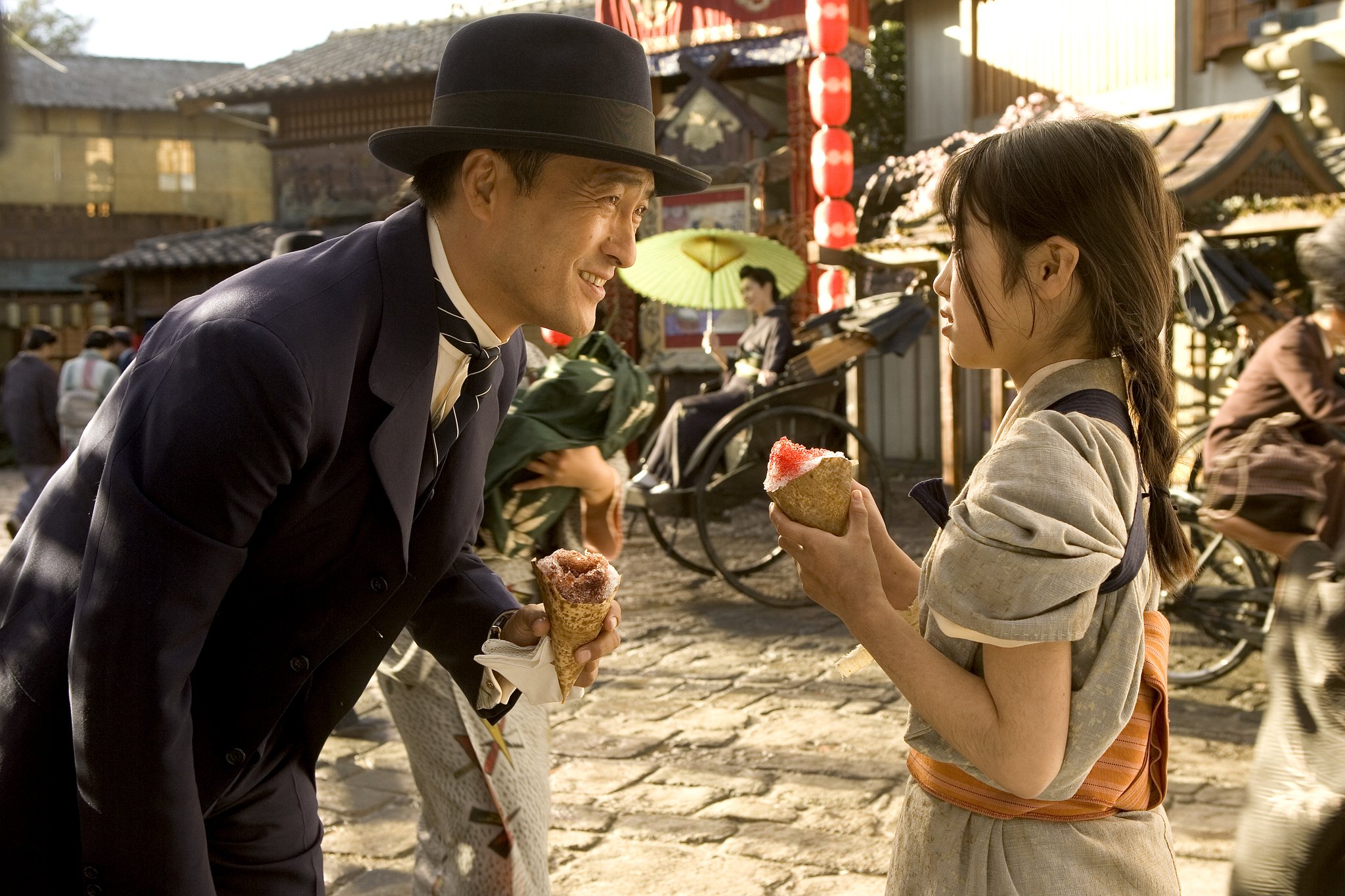
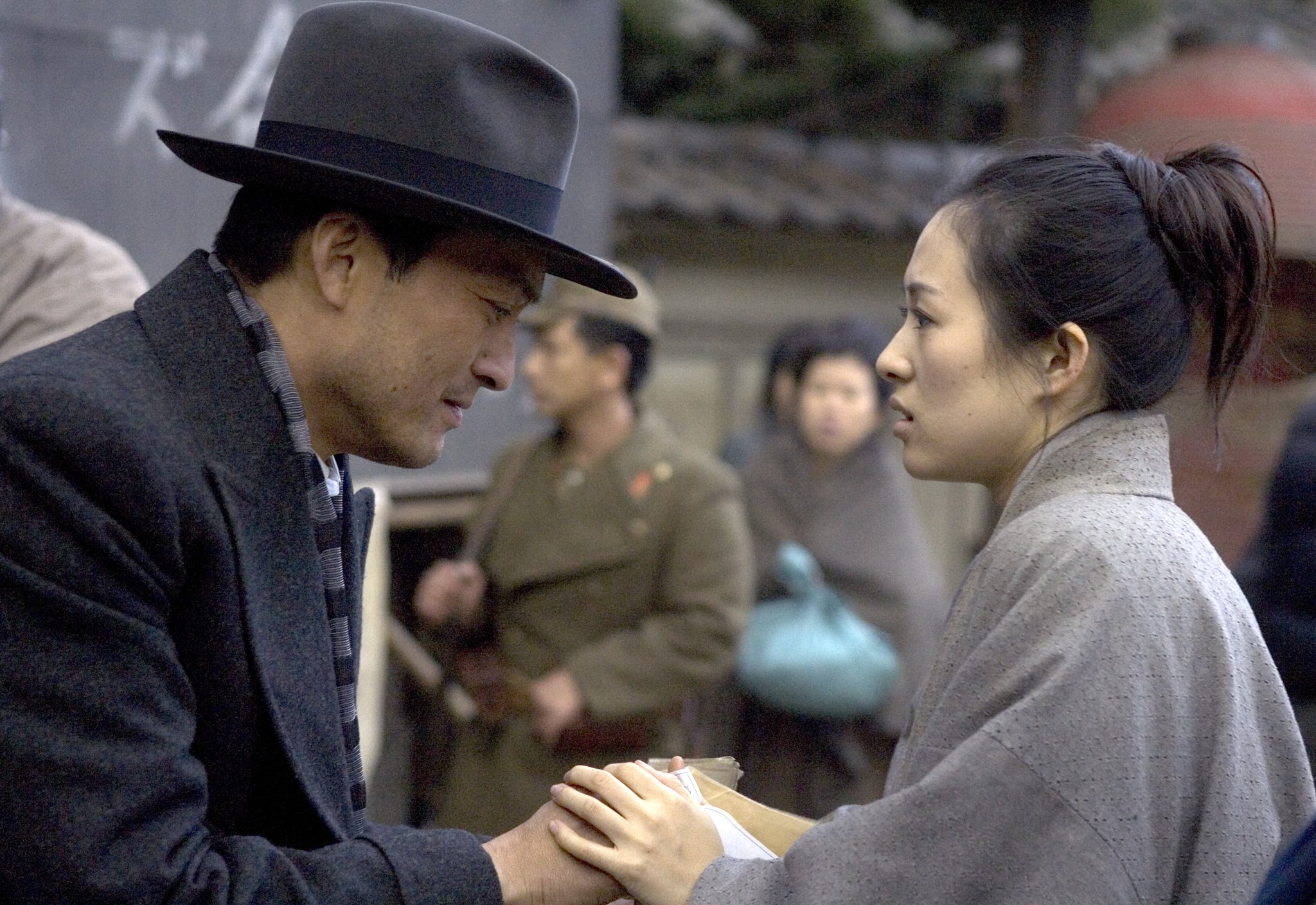
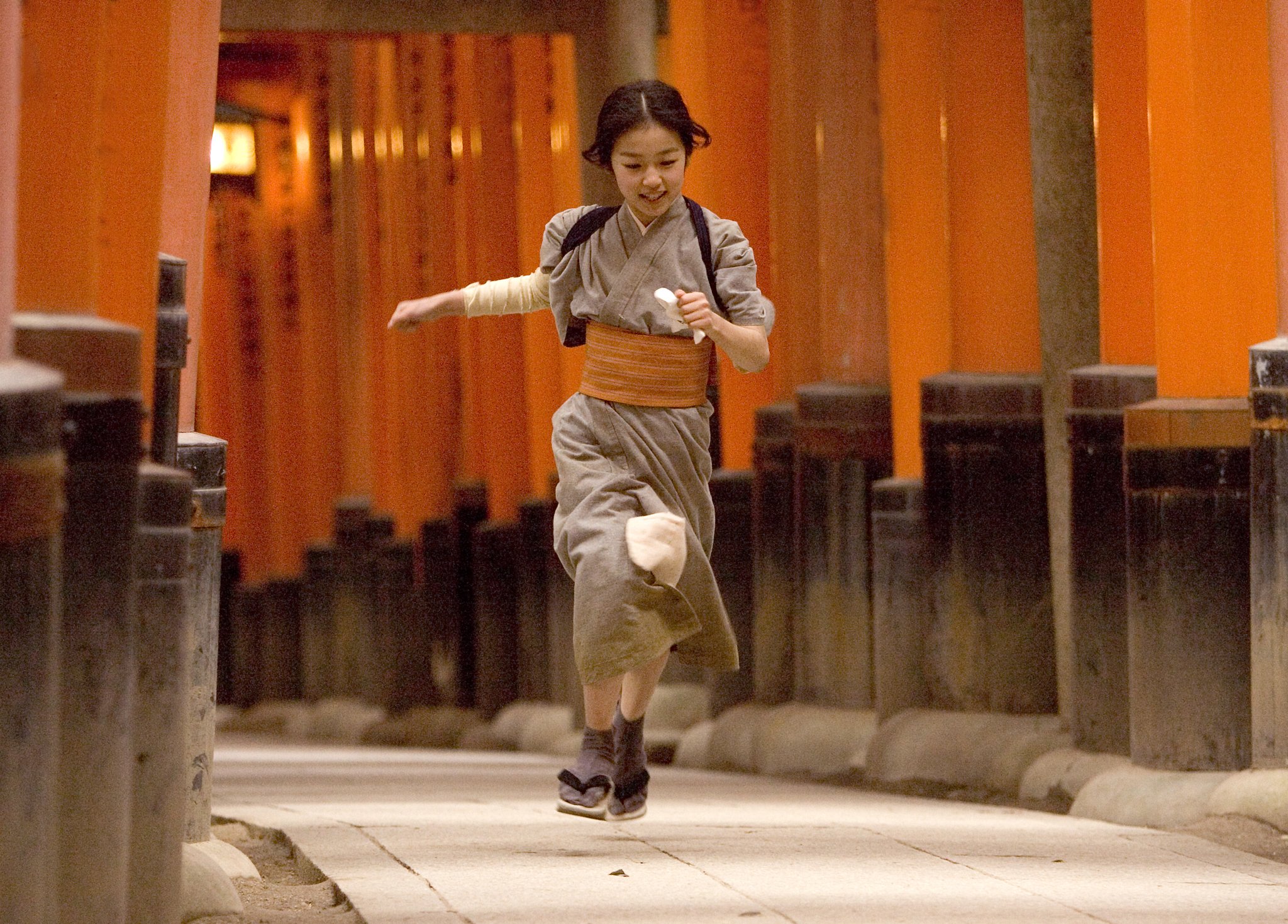
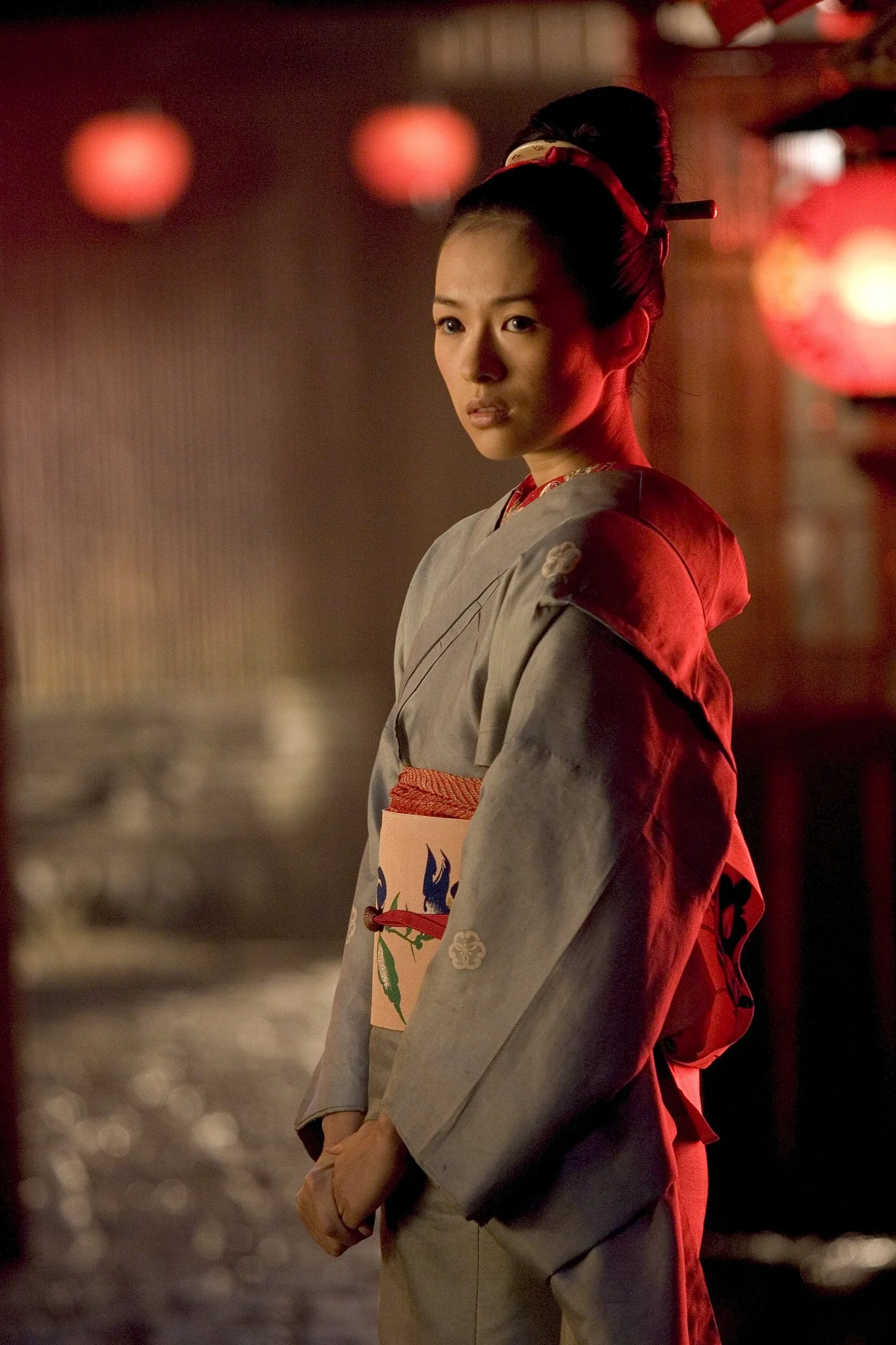
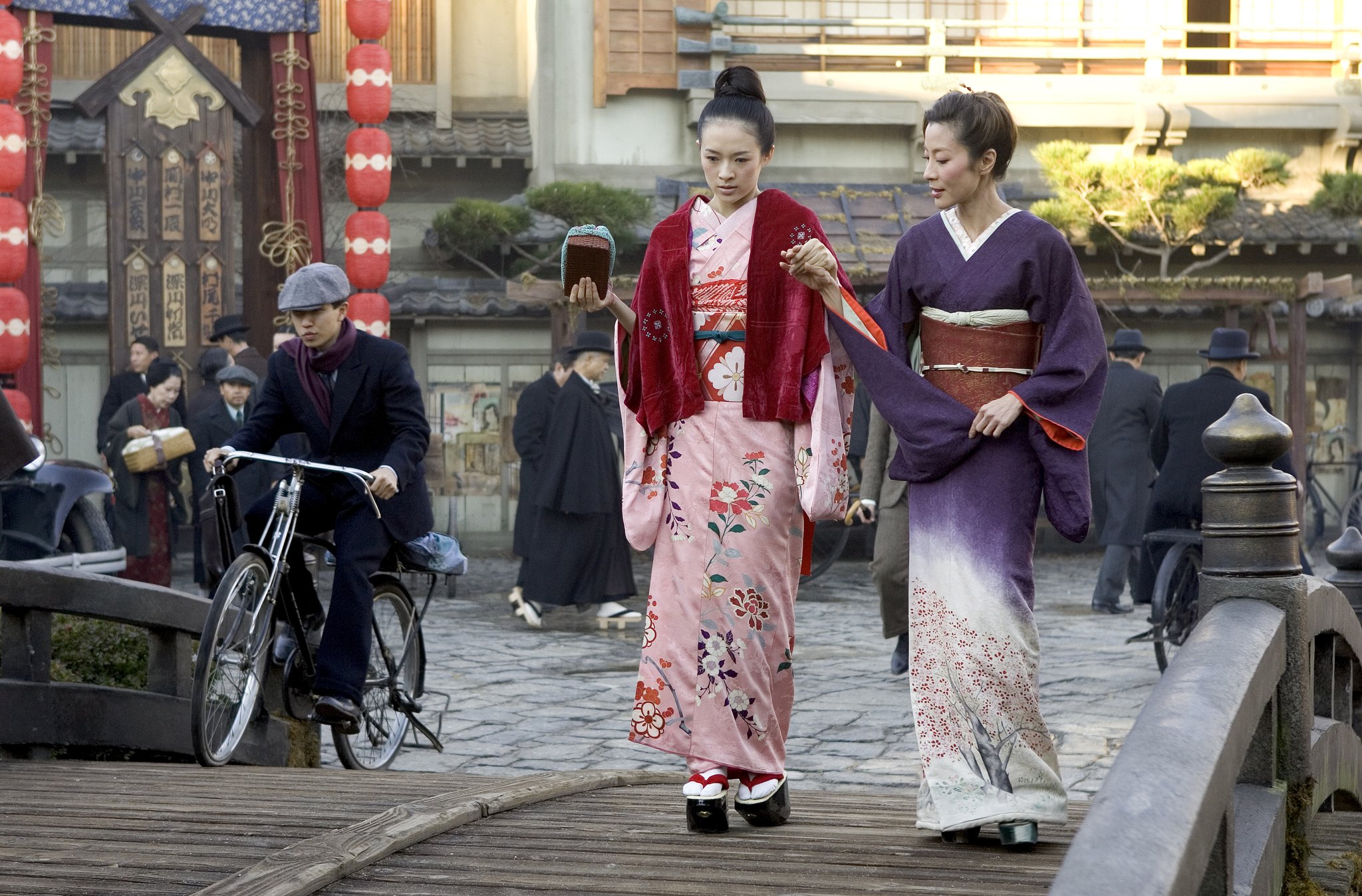
2.2 Development of the Plot
Time span in this movie is very long, and it was sectioned into Sayuri’s childhood, young adulthood and middle-age period. In the first time period, costumes of simple colors represent Sayuri’s purity. On the other hand, an oiran of the same period is styled drastically different. Her costumes are all bright red or of other bright colors to represent her popularity and glamor. As time passes, Sayuri becomes an oiran herself, but her costumes are not the same as the previously mentioned oiran. Her costumes are also bright but still clear and pure in color, representing her longing for goodness. Her styling is traditional and graceful. At the last time period of the movie, Sayuri regains her simplicity and elegance, but the color in her costumes become darker, making her seem calmer and more intellectual. Thus, we can see that the costumes of different time periods reflect Sayuri’s life experience.
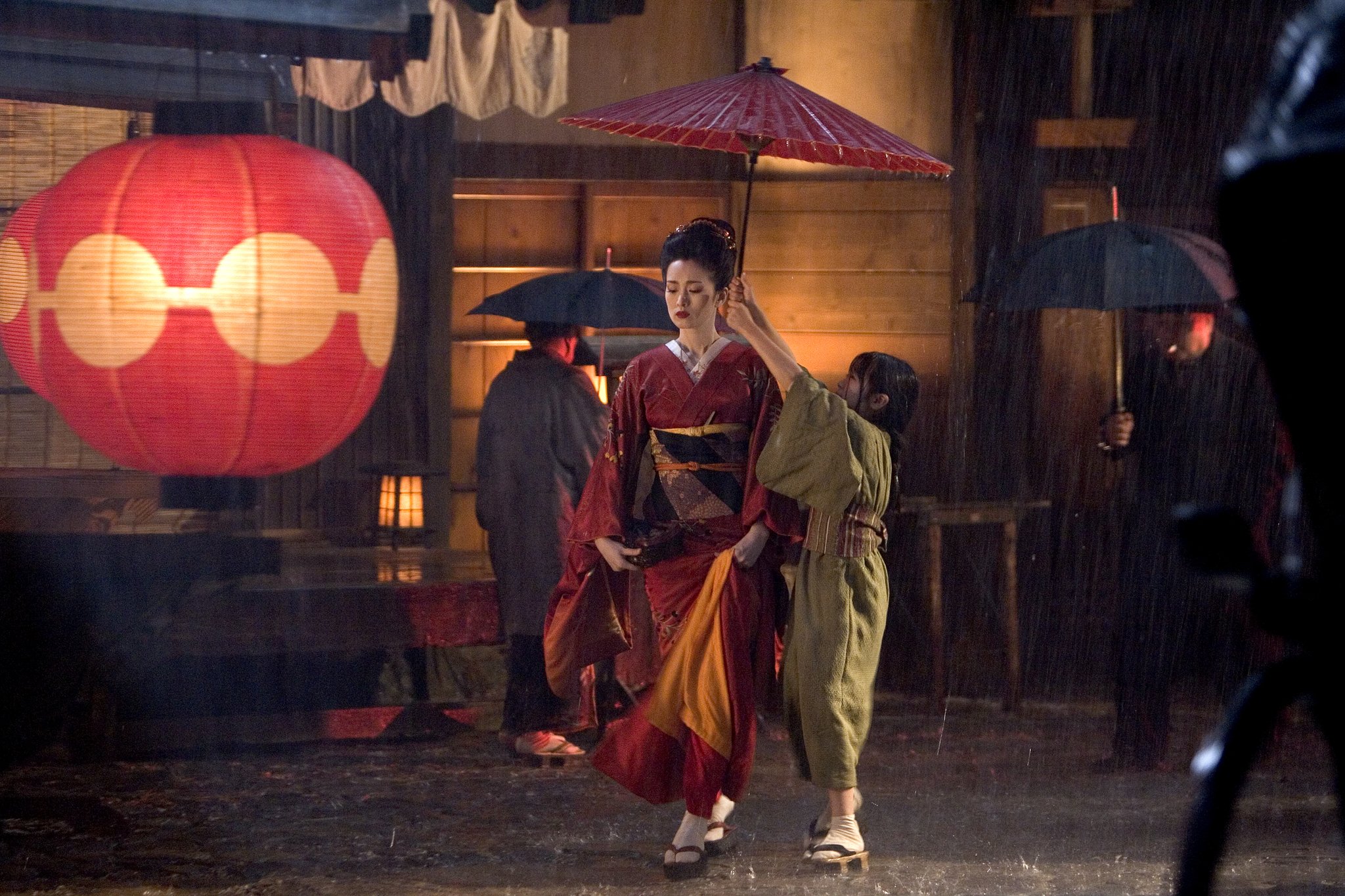
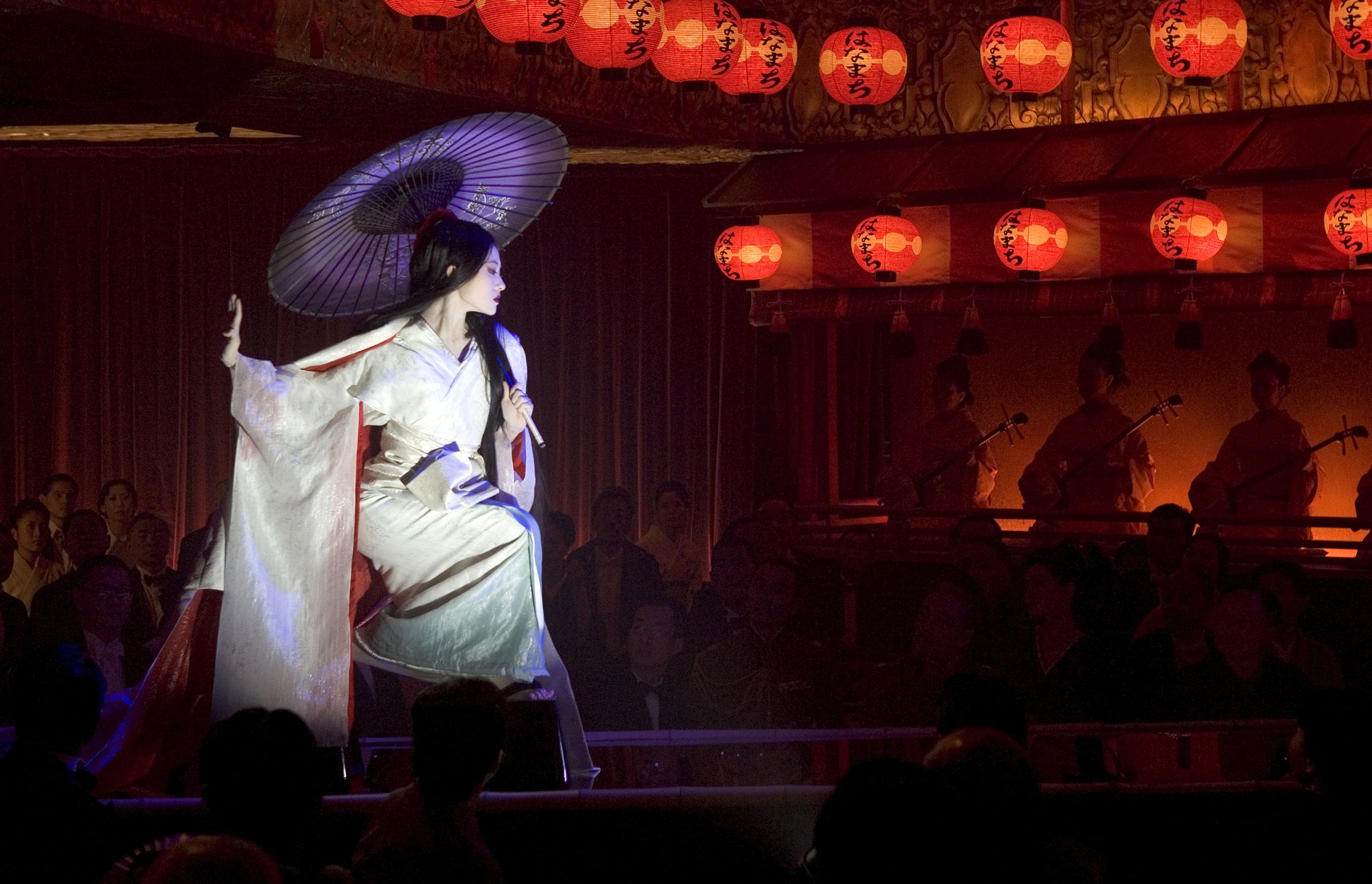
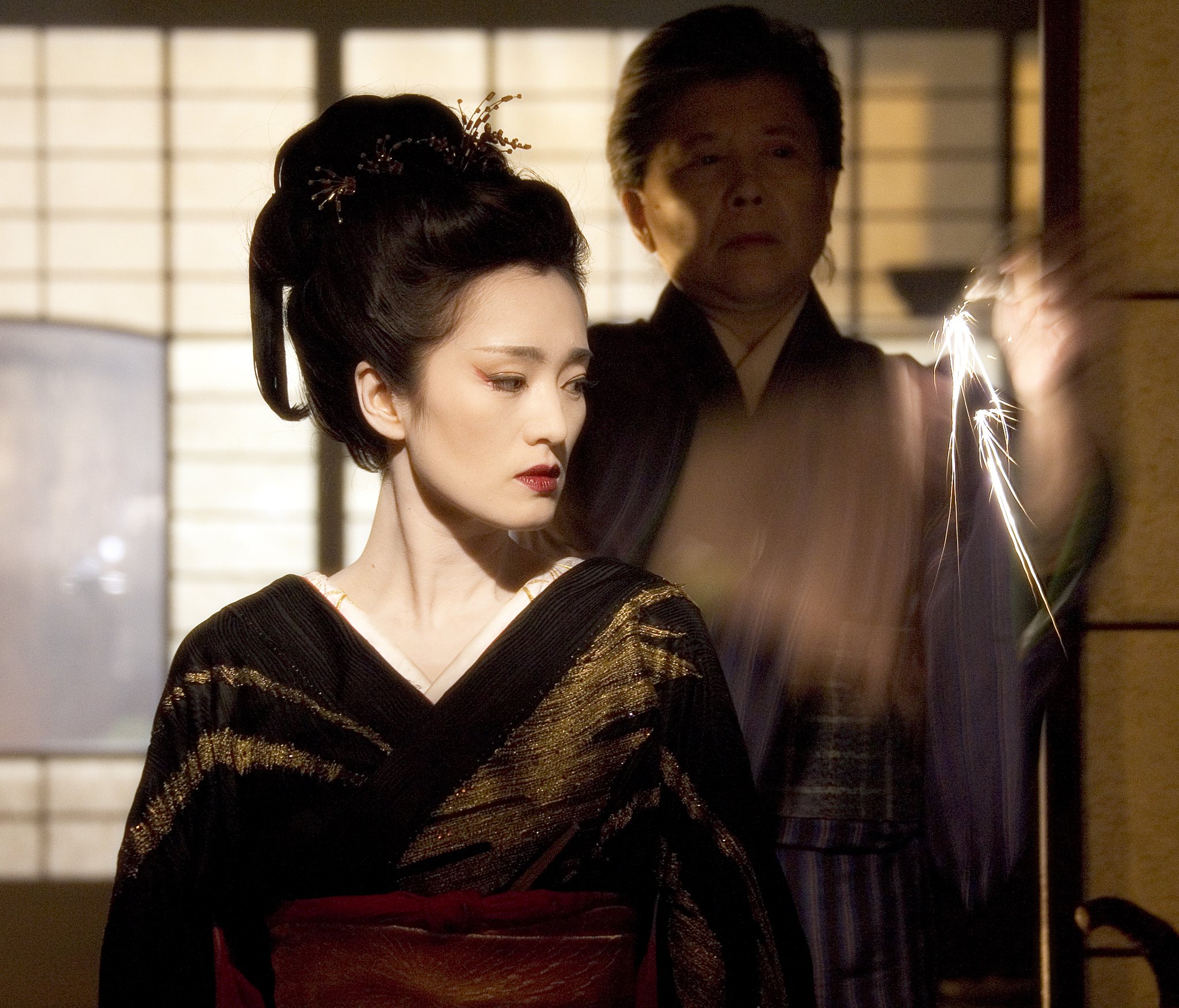
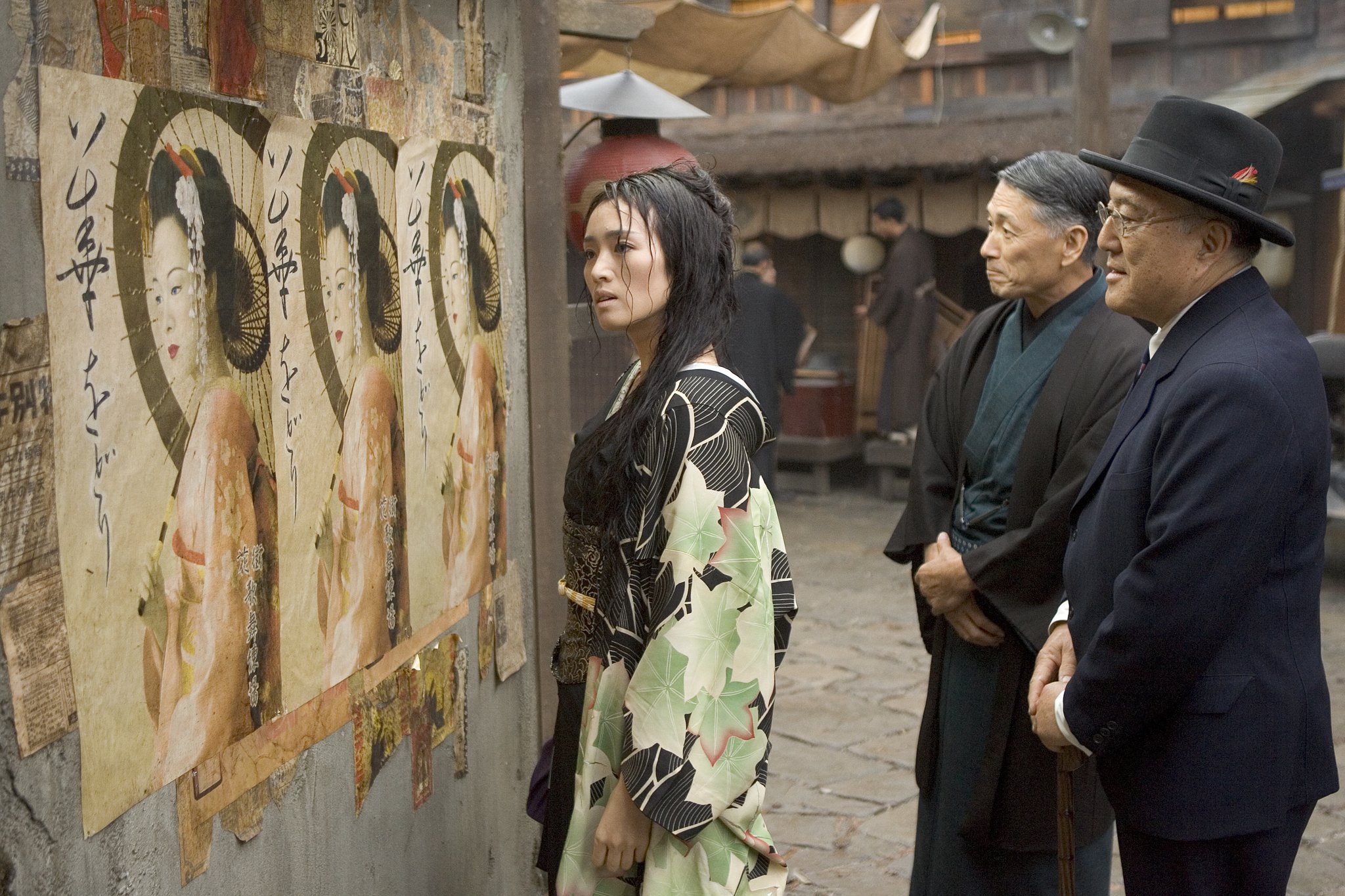
3. The Importance of Costumes in A Movie
Above are a simple analysis on how costumes contribute to characters and plots in Memoir of a Geisha. Even though costume design is only a small part of film making, it can bring different visual and psychological effects on the audience. Good movies are very serious about their costume design research, because it not only includes the development of characters and plots, it also represents the historical background and emotion influences. Fitting costumes on characters in a good project can both intrigue audiences and test the ability and sincerity of a director.
Conclusion:
Costumes are not just props for a movie, they are a testimony of the director’s understanding for the script and sincerity. A good director is able to focus on details while seeing the bigger picture, and the usage of correct costumes are all in the details. Thus, costumes in movies are worth noticing.
Bibliography:
[1] Ting, Z., 2017. Analysis on Group Characterization and Artistic Connotation in Film and Television Works from Memoir of a Geisha. Film Review.
[2] Rongyue, W., 2015. Regarding the Perfect Combination Between Story and Costume in Film[J]. Film Review.























